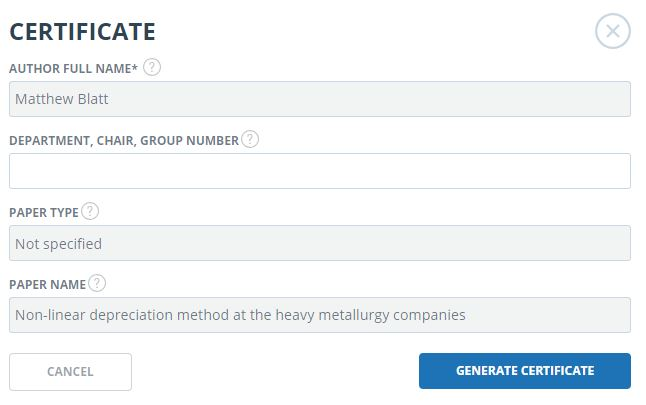Download the user manualStructural subdivision administrator’s guide for corporate version of “Antiplagiat.Structure” system
- Introduction
- Preparation for the start
- Profile
- Customer Care Service
- Adding a website
- Administration
- Management of the organizational structure of the company
- Company documents management
- Statistics
- Workspace
- Document upload
- Document check
- Text check
- Document recheck
- Viewing and editing document information
- Automatic extraction of author's name
- Manual adding the name of the document's author
- Moving a document
- Document search
- Document deletion
- Reports' history viewing
- Text metrics
- Adding documents to company's collection
- The report on the text reuse check result
- Full report
- Brief report
- Report with formatting
- Document Structure
- Suspicious document
- Downloading the report
- Direct link to report from "See results" page
- Certificate
- Contact information
Introduction
This manual is intended to familiarize you with the means of work in the "Antiplagiat" .
The manual contains information about the purpose, capabilities, features of the system, as well as a description of the actions that provide check of text documents for the detecting reuse.
Terms and definitions
|
Term |
Definition |
|---|---|
|
System "Antiplagiat" (service) |
Online tool for working with text documents with user interface on the web-site. |
|
Text similarity |
A fragment of the document text that contains the text or a fragment of the source text and is not formatted in accordance with quotation rules |
|
Text recycling |
A fragment of the document text that contains the text or a fragment of the source text, the author or co-author of which is the author of the checked document |
|
Quotes |
A fragment of the document text that contains the text or a fragment of the source text and formatted in accordance with the rules of quotation, with full bibliographic information about the source. Also quotes include common expressions, bibliography, fragments of text found in sources from the collections of regulatory documents. |
|
Text similarity percentage |
The proportion of all found similar text in relation to the total size of the checked document in characters |
|
Text recycling percentage |
The proportion of all found text recyclings in relation to the total size of the checked document in characters |
|
Quotes percentage |
The proportion of all found quotes in relation to the total size of the checked document in characters |
|
Originality percentage |
The proportion of all document text fragments that were not found in the sources used for check, in relation to the total size of the checked document in characters |
|
Report |
The result of checking the text for reuse:
|
|
Report share |
The ratio of the volume of matches that is taken into account within this source to the total volume of the document. That is, if the same text was found in several sources, it is taken into account only in one of them. When summing up the shares in the reports for all sources, a percentage of "Similarity" is obtained. |
|
Text share |
The ratio of the volume of matches of the source text to the volume of the document. The shares in the text by sources are not summed up when calculating the total percentage of matches. |
|
Report blocks |
The number of text similarity blocks from the source, taking into account the intersections of all found sources. |
|
Text blocks |
The number of text similarity blocks from a source without regard to other found sources. |
|
Collection (search module) |
The software module of the corporate version of the system "Antiplagiat", implementing the search for text reuse. The module uses a search index or a special computational algorithm to build reports. The system can have several collection. Search modules may differ in purpose, for example:
Once you have access to several search collections, you can build both individual reports and a single report for all search collections. Some collections perform searches across specialized databases with the casts of the texts of the source documents, but to obtain access to the selected search module doesn't mean getting access to the full texts of the documents it can find this collection. In the received reports, links to the documents will be indicated (their names will also be given), and when viewing the source text, it will contain fragments that coincide with the document being checked. |
|
Browser |
Software that allows users to view pages on Internet sites and access files and software associated with those pages. For example, Mozilla Firefox, Google Chrome, etc. |
|
Text metrics |
Semantic characteristics for each uploaded document. |
Purpose and conditions of use
The service is designed to check text documents for plagiarism. As a result of the scan, users receive text reuse reports. The report contains information on the sources and indicators of text similar to source, as well as detailed information with the indication of those fragments of the checked document that have been identified as text similarity. The identification is accompanied by the presentation of the matching text fragment of the borrowing source and/or the reference to the original (URL). As a result of the document check, the user can determine which part of the document is written independently and which part is reused.
To use the service you need:
- Connect to the Internet;
- Install a browser or use the browser of one of the most common types built into your operating system (MS Edge version 97 and above, Mozilla Firefox version 90 and above, Opera version 78 and above, Chrome version 92 and above).
The results of work with the system "Antiplagiat" are not the basis for claims of copyright violations, the service is aimed at use only for information purposes. In other words, we do not declare that a particular text is plagiarism, but only inform you about the presence of the same or similar text fragment. It is possible that when working with the service, you will find the text copied from other sources, including the possibility that the downloaded document is the original source. In any case, when working with the service, be careful, try to be objective and do not rush to conclusions. Remember that the service is only a tool of work, and only the user can give a real assessment to the document.
Preparation for the start
Workplace
To prepare the workplace when working with the system "Antiplagiat" it is enough to open a browser. To work with the service, browsers of the most common types, such as MS Edge version 97 and above, Mozilla Firefox version 90 and above, Opera version 78 and above, Chrome version 92 and above, can be used.
To get started, go to the service website by typing in the address bar of the browser address you received by e-mail from the administrator of the company.
So, we have a ready workplace:
- files downloaded to your computer;
- the browser is open;
- the service's website page is opened in the browser.
Log in and log out from the system
To access the system, use the login form. To do this, click on the "Log in" link in the upper right corner of the page.
If you do not remember the e-mail that you used for registration in the system, then you can use the "Remember e-mail" function on the login page. You will see a window for entering registration details from the old site: login and password. If you enter your login and password correctly, you will see the e-mail you used for registration on the old site.

Fill your credentials into the opened login form. Click on the "Show password" button, if you want to check the correctness of the password. Click on the "Log in".
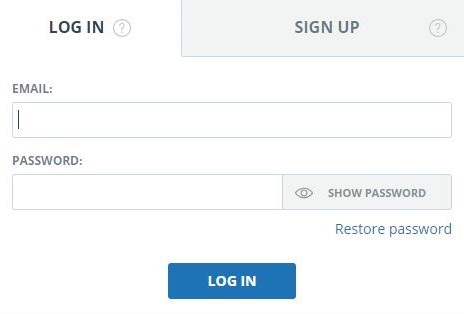
After log in the icon "Menu" will be displayed on every page of the website in the upper right corner of the page. When you click on the icon, the navigation through the sections of your account will be available. To the left of the "Menu" icon you will see a brief information about yourself: the role in the system and e-mail. Figure 4 depicts an example for the "Expert" role.

To log out from the system, click on the "Menu" icon and then select "Log out".
Role change
If your system administrator has assigned you more than one role, you will see an arrow next to the role name located at the top of the page. Click the name of the current role to view the full list of roles available to you.
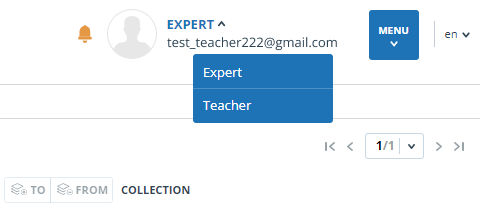
To change a role, click its name in the drop-down list of roles. After that, the page will change the name of the current role, and you will be redirected to the user account for this role. Please note that only one role is available at a time.
Profile
To go to your profile, click on the "Menu" and select the "Profile" tab.
In the profile you can review your credentials. User's data can be changed only by the company administrator.

Two-factor authentication
Two-factor authentication (2FA) is an additional security measure for an administrator's account. 2FA is implemented by linking your account to a 2FA application, which must be installed on a mobile device (smartphone or tablet).
You can install any 2FA application, but we recommend using Google.Authentificator (iOS, Android).
Applications generate one-time digital codes that will need to be entered before performing the following actions with users:
- User creation (after clicking the "Add" button on the user creation page);
- Batch creation of users (after clicking the "Import" button on the administration page);
- Changing a user (after clicking the "Change" button on the page for changing a user);
- Sending a password to the user (after clicking "Send passwords" in the action confirmation window);
- Unblocking the user (after pressing the "Unblock" button in the action confirmation window);
- User recovery (after pressing the "Restore" button in the action confirmation window);
- Impersonating into a user (after clicking the "Log in" button on the "Administration" page).
In order to set up 2FA, follow these steps:
- Install the 2FA application on your mobile device (smartphone or tablet);
- Scan the QR code using the application, or enter the text version of the code;
- After the application generates a numeric code, enter it in the field at the bottom of the page and click the "Activate" button;
- Click the "Close" button in the window that appears with a message about the successful connection of 2FA.

A window for entering 2FA will appear when performing actions with users. You will need to enter the numeric code from the application and click the "Confirm" button.

If you have not previously linked your account to the 2FA application, then a window will appear with a message about the need to configure 2FA when you perform an action with the user. The message will contain a link to the "2FA Settings" tab.

The 2FA functionality is enabled by default. 2FA is activated for free.
Important! If the administrator loses access to the 2FA application on a mobile device, then the 2FA settings can be reset by "Antiplagiat".
employees.
To reset 2FA, contact your organization's root system administrator. If you are a root administrator and you need to reset the 2FA administrator, then write an email to our Customer Care Service support@antiplagiat.ru.
Customer Care Service
If you do not find answers to questions about the system, please contact Customer Care Service. To do this, click on the "Menu" in the upper right corner and select the "Customer Care Service" tab. The system opens a window with a form to send the case.

Enter your question in the "Message" field and click on the "Send" button. Our experts will respond to your request to the e-mail, which was used to log in.
Adding a website
Our Internet search module performs a check on the already indexed sites of the web. If you find an interesting site or resource that is not included in the Internet search module, you can add it to our search module. This will allow you to build more complete and reliable reports for check through the Internet search module.
To add a website for indexing, click on "Menu" and select "Add website". Copy the link in the URL field and click "Add". You can also leave a comment about the site to which this link leads, for example, that this site is an open e-library or abstracts site.

If the site you specify is already known to our system, you will receive the message: "The Site has already been processed by our system".
Please note that the new website will be placed in the Internet search Module according to the order of the indexing queue.
Administration
View the list of users
To view the list of users, click on "Menu" icon and select "Administration" section.
The list of company users appears with the information about them.
A user with the role "Structural subdivision administrator" can view the information only about those users who are attached to the structural subdivisions and subsidiary ones that this user is managing. The other system users are not available to him.

First time you log in, you will see two users with Administrator role (learn more about roles in the "User roles" section):
-
Support Service – an employee of
"Antiplagiat"
company, who is responsible for supervision over system efficiency, troubleshooting and assistance to users of the company.
- Root administrator - administrator of your company, created by "Antiplagiat" Customer Care Service during company activation.
User roles
The system "Antiplagiat" provides the following user roles:
- Administrator - user of system, who is responsible for administration of usage of the purchased product.
- Structural subdivision administrator – user of system, who is responsible for administration of usage of the purchased product within structural subdivision.
- Expert - user of system, who checks text documents.
- Teacher - user of system, who conducts teaching activity and checks student papers in the system.
- Student - user of system, who uploads his/her papers for evaluation by the teacher.
- Supervisor - user of system, who can view all actions of all users of purchased system.
Availability of these roles depends on your system configuration.
User search
For convenience of usage of the list of users, the system provides search for users by id, e-mail, name, registration date, login date, structural subdivision, role and status.

By default, list of users is sorted by registration date in descending order. You can change sorting order in the header of the table, the direction of the arrow will change, pointing to the sorting method, and the column, which is currently sorted, is highlighted in bold.
Impersonation of administrator into user's workspace
You can impersonate into account of any company's user. To do this, click on "Log in" button in row with the selected user. Page with user's workspace under his/her login will open in the new tab. Administrator can access all features and documents of this user.
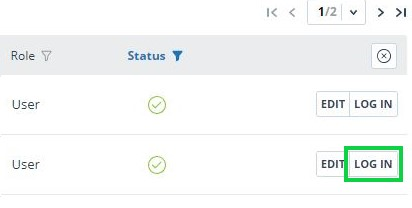
You can impersonate in only one user. To exit the impersonation mode, click on "Log out" in the user menu. After that, the administration page will open, you can continue to work with the system on your own.
Creation of a new user
To add a user to the system, click on the "Add user" button in the top menu. Fill in the fields, select a role, attach the user to the structural subdivision and click the "Add" button. The new user will be displayed in the top row of the table.
Please note that "Structural subdivision administrator" can create all users, except for users with the "Administrator" role.
E-mail, password and role are the required fields.
Multiple roles can be assigned to a user in the system. Depending on the roles assigned, the user can switch between them and perform the activities that are specific to the role.
The created user will receive a link sent to the specified e-mail for setting the individual password. If you uncheck the "Send password by e-mail" checkbox, then the link for password setting after clicking the "Add" button will not be sent. To postpone or resend the link to the password setting page, use the Editing Users section.

Only one subdivision can be specified in the "Structural subdivision" field.
The Structural subdivision administrator can indicate here the subdivisions managed by him and subsidiary ones. The administrator can specify any structural subdivision.
Editing users
To change the information about a user, click on the "Edit" button in the row of the appropriate user. The edit user's account window will open.
You can change the e-mail, user information, oblige the user to change the password (send a link to the password setting page), attach the user to another structural subdivision, change or add another role to the user in the system.
Please note that "Structural subdivision administrator" cannot assign a user the "Administrator" role. And for users with the "Administrator" role, the "Structural subdivision administrator" can only change the attachment to a structural subdivision.

To send a password setting link to the user's e-mail, flag the box "Send password to e-mail" in the edit tab of the user’s account and click on the button "Save changes".
Please note that after sending a link to the user for setting a new password, the login using the user's current password is blocked. The user must independently set a new password to continue working in the system.
You can send links to the password setting page to multiple users at the same time. To do this, flag those users in the list who need to set a new password (if necessary, select all users) at once), and in the top menu click on the button "Send password by e-mail".
After confirmation, an informational message will appear about the successful sending of letters with links to the users’ e-mails with an indication of their number.
Please note that passwords for some system users cannot be changed (root administrator, system support service).
Mass change of user attachment
To change the attachment to a structural subdivision for several users at once, select these users in the list of users by check marks and click on "Edit structural subdivision". A special form will open for selection the structural subdivision to attach the selected users to.
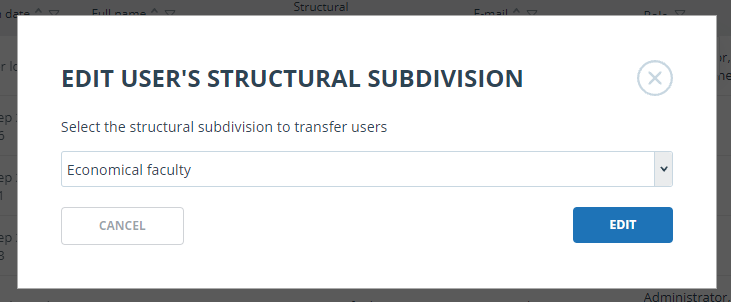
For a user with the "Structural subdivision administrator" role, the drop-down list displays the structural subdivisions that he manages and the subsidiary ones. For a user with the "Administrator" role - all structural subdivisions of the company.
Assignment of managed subdivisions to the Structural subdivision administrator
A separate parameter is provided for a user with the "Structural subdivision administrator" role - "Structural subdivision management". This parameter determines which subdivisions the Structural subdivision administrator can manage.
There are two ways to assign managed subdivisions to a user with the Structural subdivision administrator role:
- through the Structural subdivision management page (see "Management of the organizational structure of the company");
- when editing a user.

To assign managed subdivisions when editing the Structural subdivision administrator, specify the required subdivisions in the "Structural subdivision management" field. In this field, you can specify several subdivisions - the user will manage each of them.
Only users with the "Structural subdivision administrator" role have a managed subdivision. There is no such parameter for users with the "Administrator" role, and they have access to the entire structure of the company at once.
If the Structural subdivision administrator is not assigned with a structural subdivision (he does not manage any structural subdivision), then he sees the message on the Administration, Collections, Company structures page:

Blocking and deleting users
You can use the menu above the list of company's users to block and delete the user's account. On the same form, you can restore and unblock the user.
To block/delete several users at the same time, you need to mark appropriate users and click on the "Block" button or "Delete" button.

To block / delete all users on the current page, flag the ID box and click on the "Block" button or the "Delete" button.

To block / delete all users, click on "Select all users", and then on the "Block" button or on the "Delete" button.
To deselect users, click on "Deselect". In this case, all users will be deselected.
By default, the user list displays only activated users. To see deleted or blocked users, click the filter icon next to the "Status" column, select the status "blocked" or "deleted" and then click "Apply".

Mark appropriate users, click on the "More" button and select the "Unblock" or "Restore" action.
Check quotas
The limitations of users for checks managment is available for administrator. Limitations are set via quotas which show how many checks can be performed by user.
Click on "Menu" icon and select "Billing" to start working with quotas. Here in "Check quotas" tab you can:
- veiw the list of users, quotas assigned to them and remaining checks within quotas;
- set quotas for checks to one or several users;
- set default quotas for checks;
Please note that users without quotas can perform checks until the checks of the company run out.
Users list and information about quotas are displayed in "Check quotas" tab. Current limitation of user for checks is specified in "Quotas" column. The rest of the quota is specified in the column "Checks remaining".
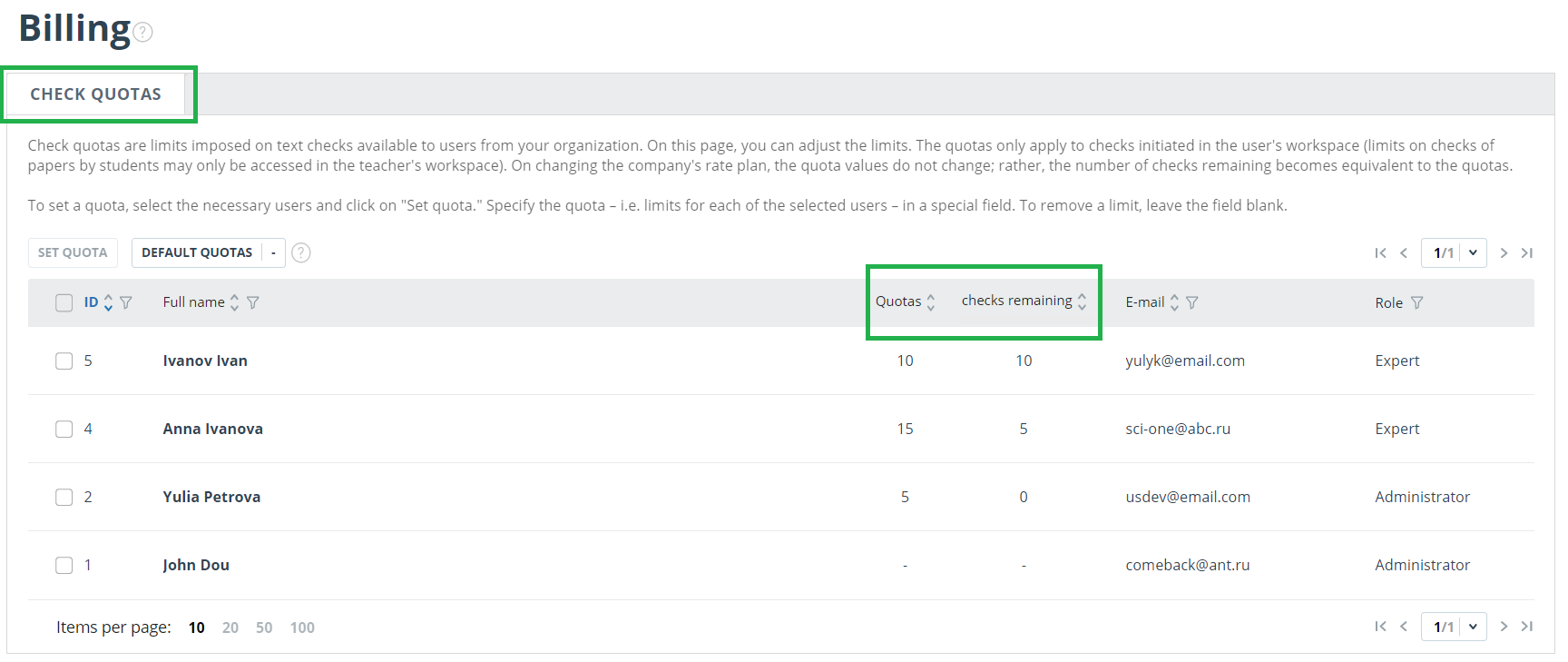
Assigning quota to user
For assigning quota to user please perform following actions:
- Select one or several users which are subject to quota, by ticking the mark.
- Click on "Set quota" icon.
- Specify quantity of checks which available for users and click on "Apply" icon.
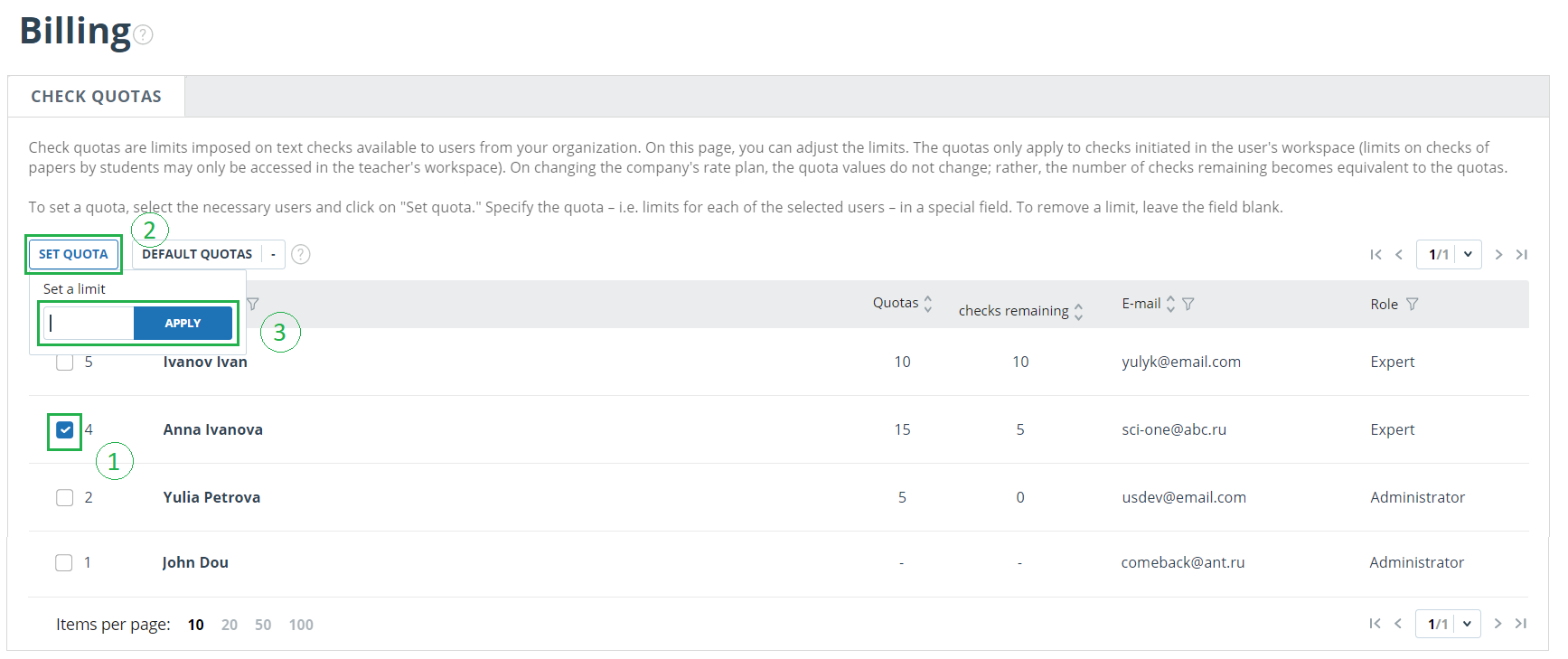
Default quotas
Administrator can set default quota. Value which specified in default quota is used for users without assigned manually quota.
If default quota is absent, then limitation for checks during the creation of new user setting manually.
Please note that when a company is created, the default quota is set to 10 checks. You can independently change this value on the "Billing" page, the "Check quotas" tab.
Please note that subdivision administrator can't set default quota.
For setting default quota please perform following actions:
- click on "Default quotas" icon;
- specify quantity of checks which available for users;
- click on "Apply" icon.

Management of the organizational structure of the company
For the best correspondence of the "Antiplagiat" system to the hierarchical structure, it provides for the "Management of structural subdivisions" functionality. This tool allows you to:
- enter the information about the organizational structure of the company into the system;
- attach system users to various structural subdivisions;
- delimit access and appoint responsible persons for structural subdivisions.
As part of this functionality, all users are linked to structural subdivisions. In this case, the role "Structural subdivision administrator" (SS Administrator) is provided, which is responsible for managing a specific structural subdivision. Such a subdivision is called managed. A subdivision can have subsidiary subdivisions, in this case it is called the parent subdivision.
To go to the management of structural subdivisions, click on the menu item "Company structure". The structural subdivisions management page is used to display the organizational structure of your company. Here you can create, edit and delete structural subdivisions.
When the structure has not yet been created in the system, the page looks like this:
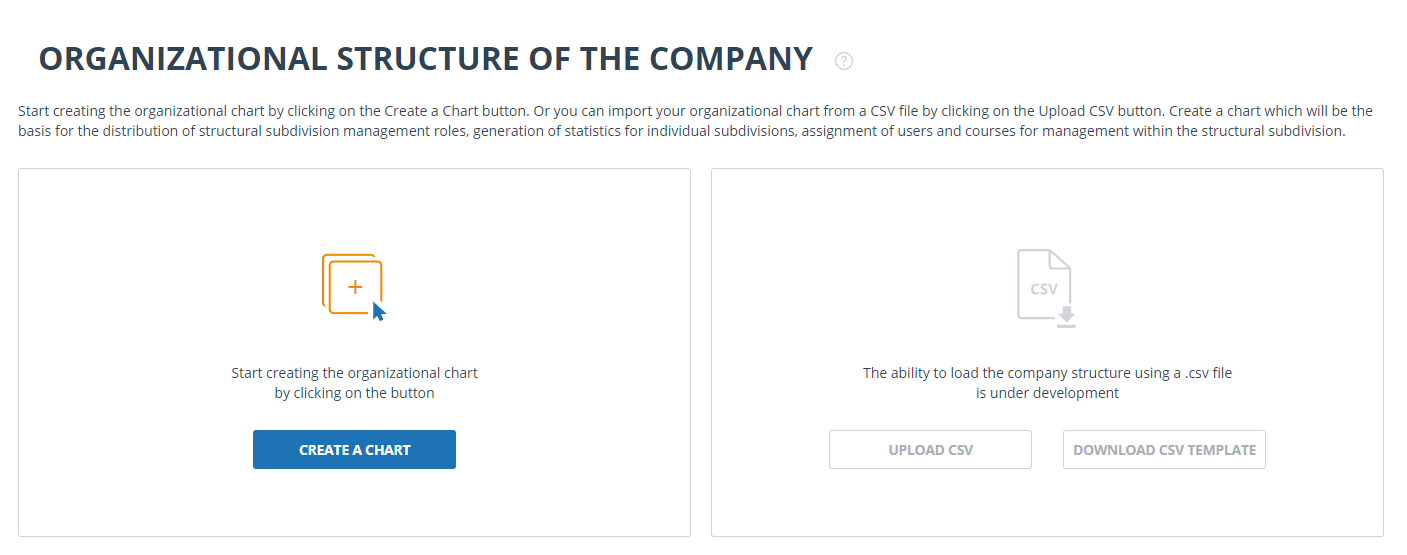
To proceed to creating a scheme, click on "Create a scheme" - the site will display a form for creating structural subdivisions in the following form:
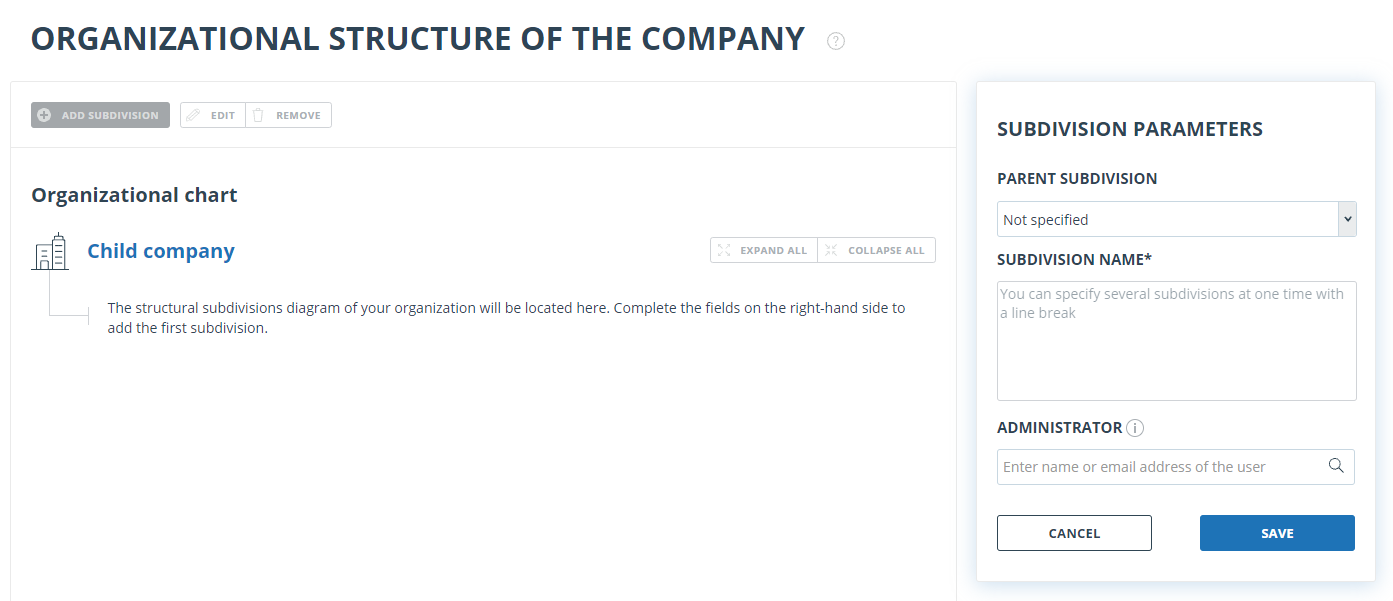
The structural subdivisions are displayed on the page with the already created structure. If the SS Administrator is viewing the page, then he sees only the structural subdivisions managed by him and subsidiary ones.
For the convenience of displaying the entire scheme of structural subdivisions on this page there are arrow icons near the name of the subdivisions on the scheme and the buttons "Collapse all", "Expand all". To hide / show all subdivisions in the scheme, click on "Collapse all", "Expand all". To hide / show subsidiary subdivisions, click on the arrow icons next to the subdivision name on the scheme.
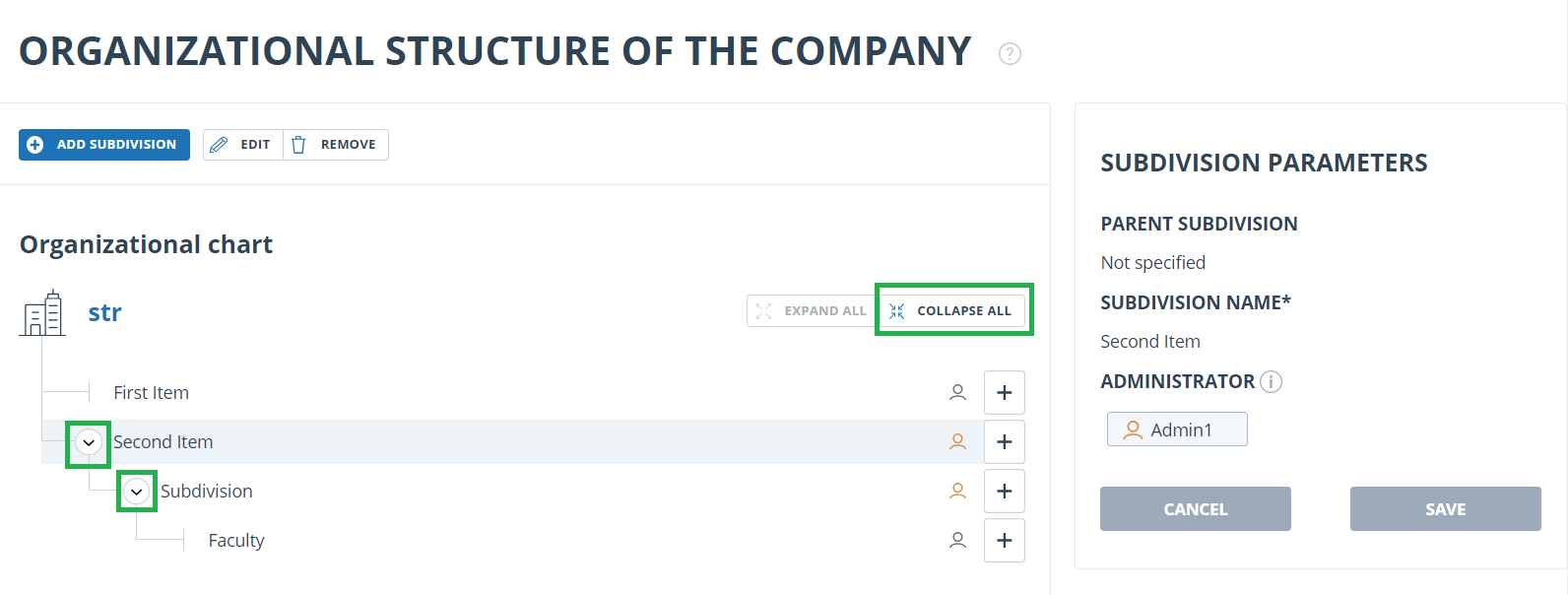
If a Structural subdivision administrator is assigned to a subdivision, the icon to the right of the subdivision name on the scheme will be orange. For subdivisions that do not have SS Administrators managing them, the icon is gray.
Creation of structural subdivisions
To create a new structural subdivision, click on "Add subdivision" or on the "+" icon. On the right side of the screen, the “Subdivision parameters” block will become editable. Here you can specify the parent subdivision, the names of the subdivisions to be created and their Administrators.

Parent subdivision. This field is required. The selection of the parent subdivision is carried out from the subdivisions available to you. If you are a Structural subdivision administrator, then the choice is made from the subdivisions that you manage, and subsidiary ones. If you are an Administrator, then you can specify any subdivision here or leave this field blank.
Subdivision name. This field is required. You can specify several names in it - each on a new line. Then the system will create a separate subdivision for each of the specified names.
Names cannot contain *; and \ characters. The name of the subdivision must contain letters.
Important! A parent subdivision cannot have two subsidiary subdivisions with the same name. The case does not affect the uniqueness of the subdivision name.Administrator. To assign an Administrator for the structural subdivision being created, start entering his full name or e-mail in this field. Select the desired users found by your request. The search is carried out only for users with the "Active" status with the "Structural subdivision administrator" role. If the user has been assigned several roles, the role "Structural subdivision administrator" must be among them.
To create a subdivision, click on "Save".
Editing structural subdivisions
As a user with the "Structural subdivision administrator" role, you cannot edit the organizational subdivisions that you manage - only those that are subsidiary ones inside them. If you are a user with the "Administrator" role, then you can edit subdivisions without restrictions.
In order to change any subdivision, first click on it, and then on the "Edit" button - the fields in the "Subdivision parameters" block will become available for editing.
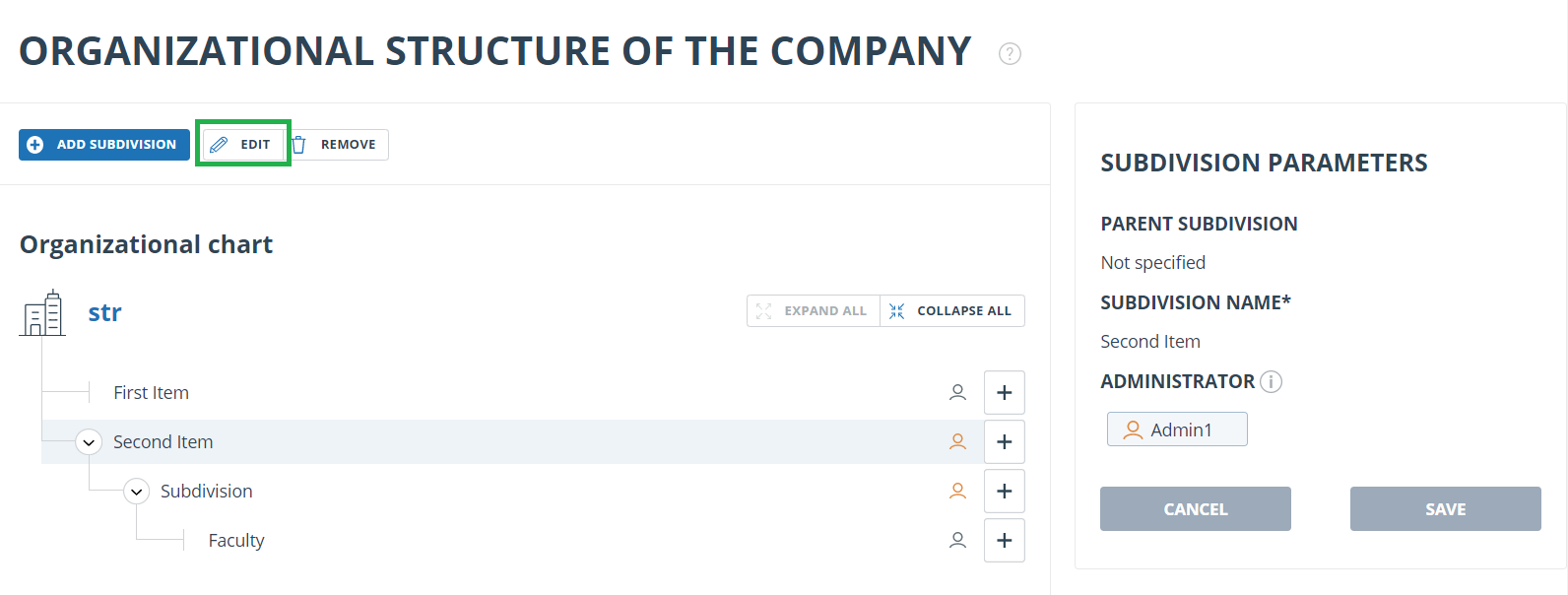
For a subdivision, you can change the parent one, change its name and the list of its Administrators. After you have made the changes you want, click on "Save".
Deleting structural subdivisions
To delete a structural subdivision, select it on the diagram and click on "Delete".
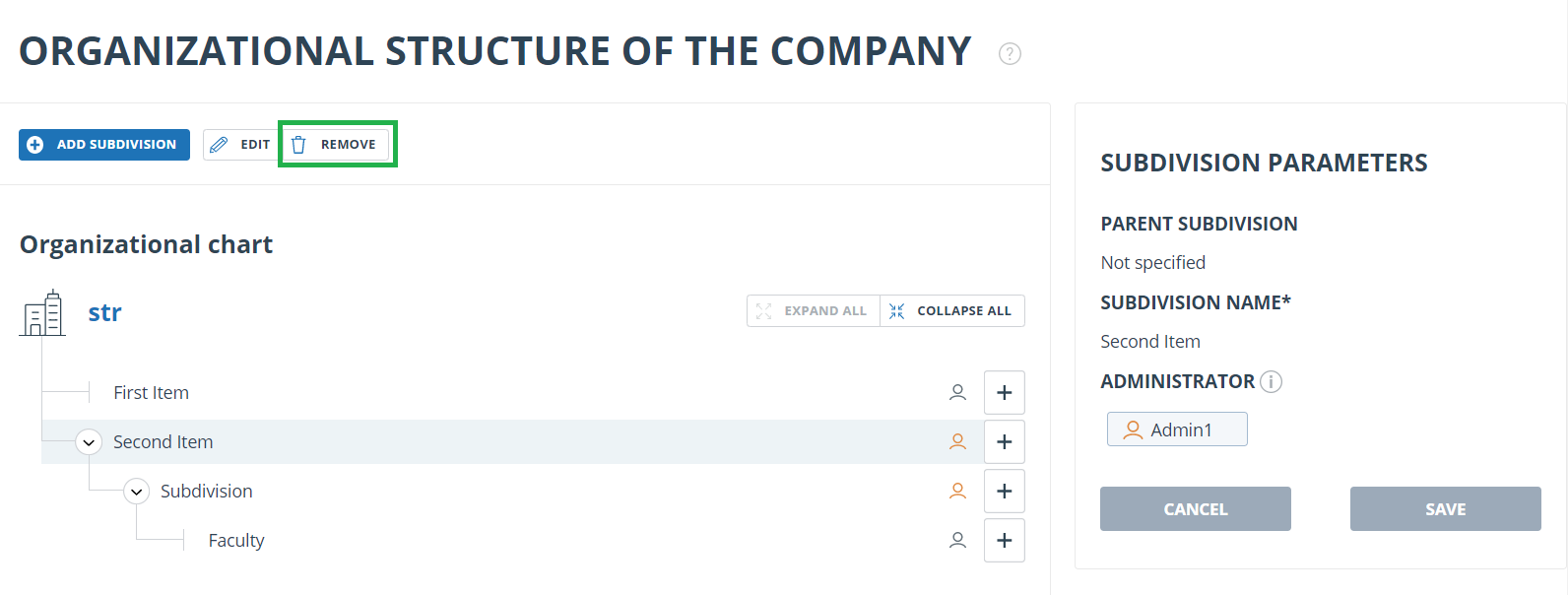
Depending on whether it contains users and documents, the system will offer various options:
- if users and documents are not attached to the subdivision, then the system will delete the subdivision and automatically detach the "Structural subdivision administrator" from the management;
- if there are documents attached to a subdivision in the system, then when deleted, all documents from this subdivision will be automatically transferred to its parent one. If the subdivision does not have a parent one, then the documents will not be attached to any subdivision.
- if users are attached to the subdivision, the system will offer to move all users from the deleted subdivision, and only then delete it. To do this, click on "Delete manually" - you will find yourself on the administration page. For more information on how to assign users to an organizational subdivision, see the "Administration" section. You can simply delete a subdivision by clicking on "Reassign and delete" - in this case, the system will automatically transfer all users from the deleted subdivision to its parent. If the organizational subdivision does not have a parent, then users will not be assigned to any organizational subdivision.
As a user with the “Structural subdivision administrator” role, you cannot delete organizational subdivisions that you manage - only those that are subsidiary inside them. If you are a user with the “Administrator” role, then deleting organizational subdivisions is available to you without restrictions.
Batch mode of editing of users
The administrator has the ability to edit the users of the company in batch mode. Batch editing of users is carried out through editing of a csv-file with a list of users.
Format of the file:
- each line of the file contains information about one user;
- the line consists of fields, separated by semicolons;
- order of fields: ID, last name, first name, middle name, role, e-mail, delete.
Batch editing allows you to:
- create a new user (field for ID must be empty);
- delete a user (in the "Delete" column you need to put "1", otherwise this field must be left empty);
- change user’s data (full name, e-mail);
- change user’s role or add another role. Roles should be listed via slash «/».
We recommend to edit the file in csv format in text editors ("Notepad"," Notepad++", etc.). To save the edited file in Excel, use the "Save as" button and select the format *.csv (separated with comma).
During batch editing of users, the System subdivision administrator in the exported csv-file sees only those who are in the structural subdivisions he manages and subsidiary ones. At the same time, users with the "Administrator" role will not be exported. Using batch editing, the System subdivision administrator cannot assign this role to anyone and create users with this role.
To batch edit the list of users, you need to do the following actions:
- Click on "Export" in the top menu of the "Administration" section and save/open the file on your computer.
- Make the necessary changes without changing the first line of the file, and save the modified file in the format *.csv.
- Click on "Import" and select the corrected file in the top menu of the "Administration" section.

When exporting a csv-file with changes, a window will open for selecting a subdivision for attaching users who will be created using this file. A user with the "System subdivision administrator" role can select only from the structural subdivisions managed by him and subsidiary ones. A user with the "Administrator" role - from all divisions of the company.

After importing of the modified csv-file under the list of users, the information about correctly filled users will be updated.
In batch editing mode, you may encounter an error if:
- field E-mail is empty;
- there is no id field for the user, which has been edited by you;
- user’s role is entered incorrectly;
- the "Delete" column has an incorrect value (an incorrect value is all values except "1").

Company documents management
The administrator of the company can view all the documents of the company. To do this, click on the "Menu" and select the "Collection" section. A list of company documents opens, displaying documents uploaded by all users of the company.
The Structural subdivision administrator can view documents attached to his managed structural subdivision and subsidiary ones in the "Collection" section. A user with the "Administrator" role has access to all company documents without any restrictions on structural subdivisions.

To which structural subdivision the document will be assigned depends on how and by whom it was uploaded to the system. When uploading a document to the system, it is attached:
- to the structural subdivision of the user who uploads, if the document is uploaded to the user’s workplace;
- to the structural subdivision of the Teacher, to whose task the document is uploaded;
- to the structural subdivision that was selected when uploading the document into the Storage (see below).
Documents uploaded by the user to his workplace are automatically attached to the structural subdivision to which the user belongs. When you change the attachment of a user to a structural subdivision, all previously uploaded documents are still related to his old structural subdivision. The user has access to all his documents, regardless of which department they belong to.
Documents uploaded as student papers are automatically attached to the structural subdivision of the Teacher who created the task. If the Teacher changes the structural subdivision to which he is attached, then after such an update the documents uploaded to his tasks are attached to the new structural subdivision of the Teacher.
If the Teacher's structural subdivision changes, then the documents uploaded to his tasks before the change of subdivision are still available to the Administrator of his old structural subdivision. The documents uploaded to the task after changing the subdivision are visible to the Administrators of the new structural subdivision of the Teacher. The Teacher retains access to student papers, regardless of how his assignment to structural subdivisions changes.
Company documents revision
On the left side of the "Folders" panel you will see the sections where all uploaded company documents are stored.
The Structural subdivision administrator sees all existing folders, but inside them he sees only documents belonging to users of his structural subdivision. If it is necessary to create a new folder, edit or delete an existing one, the Structural subdivision administrator must contact the Company administrator.
The "Storage" section is available and is displayed only if you have your own collection maintenance connected.
Please note that "Company documents", "Storage" and "User documents" are system folders. You cannot delete, move, or rename system folders. You can add, delete, and rename documents and folders only in the “Storage” folder.
The section "Company documents" contains a list of all company documents uploaded by users and administrators, both in their personal accounts and in the storage. Additional information, including author, upload time, and status, is displayed for the documents.
Sorting, filtering and searching by table columns is similar to the "Administration" section.
"Storage" is the company's own collection, which used to check the documents of the company's users. The structure of this section is similar to the section "Company documents". There are two types of placing in index for the documents in the "Storage" - in index of approved and in index of text similarity. Duplications, which was founded via documents from index of approved, relate to citing percentage. If the document is placed in index of text similarity in the "Storage", then duplications relates to text similarity percentage in text reuse reports.
Section "User documents" contains documents uploaded by users of the company to their offices. The structure of this section is the same as in the section "Company documents".
Adding and deleting the documents from the index
If you want to search for reuse in the system "Antiplagiat" carried out on the documents uploaded by your organization, add the document to the indexation. Check the documents box and select the appropriate action from the top menu. Similarly, the process of extracting from the index.

User documents are placed in the similarity index. Only documents from the company's storage may be in the index of approved. To place documents in the index of approved, open the "Storage" section, tick the documents with checkmarks and click on the "To Index" button in the top menu. In the drop-down menu, select the "To approved index" button.

Deletion and restoring of company documents
To delete documents, check the documents checkbox and click the Delete button in the top menu.

To restore previously deleted documents, click the filter icon next to the status column name, select the deleted status, and then click Apply. Now check the box documents and click on the "Restore" button in the top menu. Once recovered, the documents will appear in the root folder of the users who previously downloaded them.
Adding the document to the "Storage"
If you have a set of documents and you want to check users' documents by them, you need to add these documents to the "Storage". To do this, select the appropriate folder in the "Storage" and click "Add document".
Documents are added to the "Storage" without checking and reporting. Documents uploaded to the Vault are added to the index of their own collection as soon as they are loaded, but they can be removed from the index once they are loaded.
In Storage, you can create, delete, rename, and move subfolders.

For placing documents in index of approved at the moment of uploading in "Storage", click on "Approved for citing" button on uploading to "Storage" form.
When adding documents to the Storage, you can choose which structural subdivision they will be attached to. To do this, indicate the required structural subdivision in the form for adding a document.
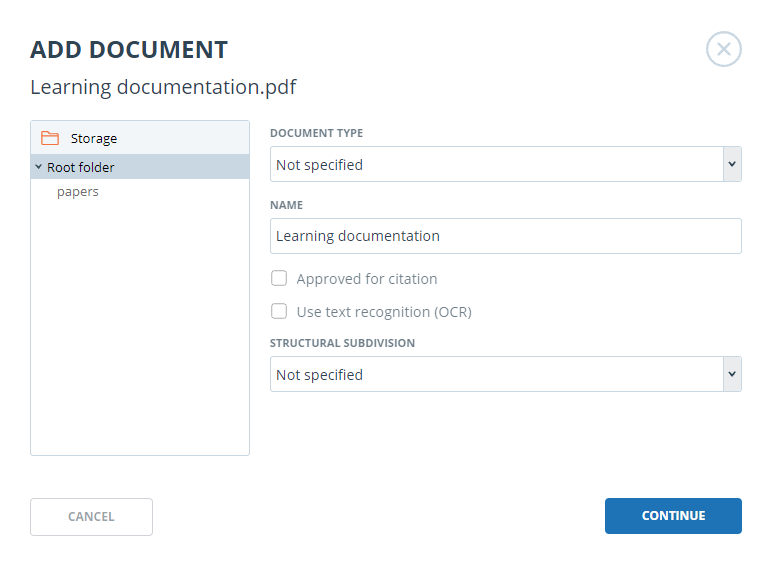
Loading of documents in batch mode
The administrator of the company has the ability to batch download documents in the "Storage" of the company. To do this, select "Batch upload" in the "Storage" section.

To batch download documents to "Storage", you need to prepare documents for loading and a file with attributes of the loaded documents. A file with attributes will allow you to search by standard attributes in the future, also you can create your own attributes that will be assigned to the document. They will be displayed in the information about source during the search for reuses.
Main fields (file's name) and additional fields (all other fields) include in a composition of the file with attributes in the format .csv. You can edit the headers for all attributes except the attribute "Name of file".
Manual for filling of the file with the attributes is situated inside a template file. The template is available for loading in the top panel of the "Batch upload" page.
Loading of a file with attributes is optional, and you can choose not to use it in the batch loading of documents. Then the loaded files will be assigned standard attributes, as during the loading of a single document. If you do not want to use the file with attributes, you can skip the first 3 paragraphs from the following procedure for batch loading of documents.
To batch download documents, you need to do the following actions:
- Upload the file template with the attributes for the loading. To do this, click on the "Download file template with attributes" button in the top menu.
- Fill the uploaded file. The file contains the manual for filling of the file.
- Click on "Upload file with attributes" and select the already modified file in the top menu.
- Click on "Add documents" and select plenty of files for the loading.
- Please note: if you will close the page during the process of loading of the documents, the data will not be saved. To download the data, you will have to go through all the steps again.
- Now documents are previously loaded in the system, but they are not saved in it. White color indicates the documents that have been loaded and are available in the file with attributes. Red color indicates the documents that have been loaded, but are missing in the file with attributes. Grey color indicates the documents that are available in the file with attributes, but have not been marked during the selecting of the documents for the loading.
- If necessary, you can filter by the presence of the loaded documents in the file with attributes (present in the manifest; not present in the manifest; present in the manifest, but not loaded).
- If necessary, you can delete some documents. To do this, mark the appropriate documents and select "Delete" in the top menu below the list of documents. Documents will be deleted from the temporary folder and will not be loaded to the "Storage".
- You can tick a "Approved for citing" mark in form of uploading in "Storage" in Adding documents window for posting documents in index of approved immidietly at uploading into "Storage".
- To download the documents to "Storage", click on the "Send documents to storage" button in the top menu on the left. Window of adding of the documents will open.
- In Adding documents window you can select the documents' type (one for all) and the "Storage" folder , in which you want to download your documents (the root "Storage" folder is active by default). All uploaded documents will be automatically placed in the index of the company's own collection.
- Specify the structural subdivision to which all uploaded documents will be attached.

After the loading process is completed, you will receive a message, indicating the number of loaded documents.
Statistics
To view system statistics system usage please go to the page "Statistics" by clicking on the respective section of "Menu". On this page, you can generate reports both by the company level, and by users. The date of statistics most recent update is displayed in the upper right corner of the page.
"Statistics" page can consist of the "General statistics" and "University Statistics" tab. In the "General statistics" tab you can generate reports that reflect the general actions of users. In the "University Statistics" tab located statistics which are specific to universities.
Please note: The statistics are updated once a day, so the report will not include verified documents for the current day.
Detailed system use statistic
The statistical report "Detailed system use statistics" displays the main quantitative indicators of the company. Statistics are aimed to assess the extent of system utilization and monitor the number of checks.
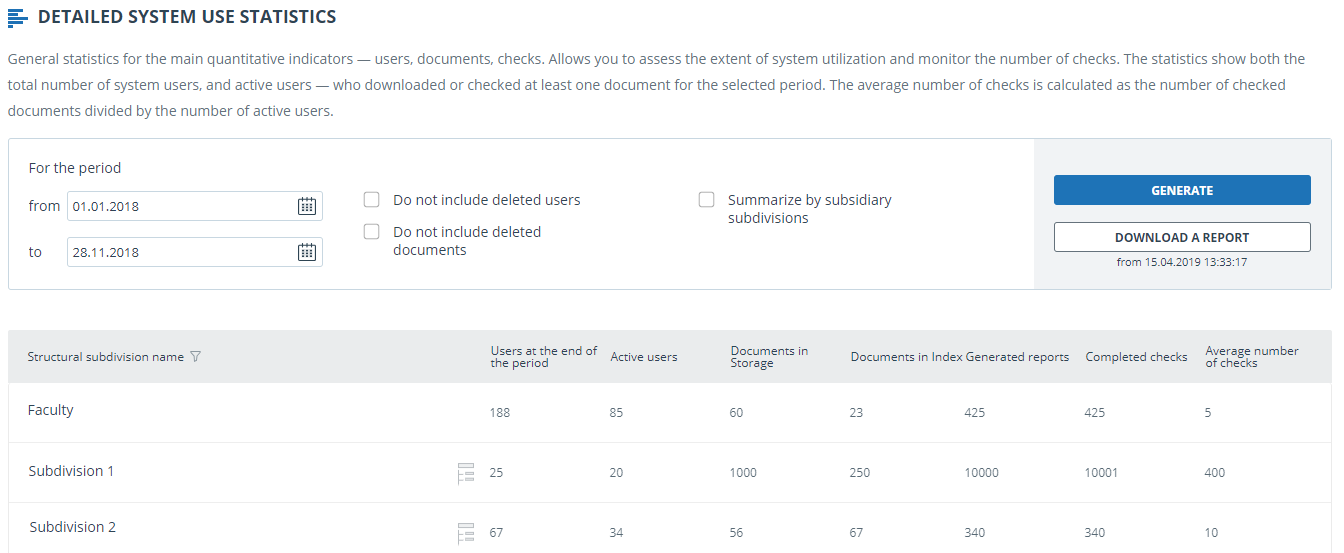
To generate the statistical report, select the time period for which you want to build a report, and click on the "Generate" button.
To view the actual data without taking into account deleted users and/or documents, mark the box next to "Do not include deleted users" and/or "Do not include deleted documents".
You can get statistics for each structural subdivision separately, or take into account the results of the subsidiary subdivisions so that the parent subdivision will include the totals for the parent subdivision and all its subsidiary subdivisions. To include the subsidiary structural subdivisions into account, mark the box next to "Summarize by subsidiary subdivisions".
The following metrics are displayed in the generated statistical report:
- The name of the structural subdivision according to the hierarchy established in the company
- Users at the end of the period. The number of users created in the company from the very beginning till the end date of the selected interval.
- Active users. The number of users who have uploaded or checked at least one document during the selected period.
- Documents in Storage. Number of documents uploaded to the Storage during the selected period.
- Documents in Index. Number of documents added to the Index during the selected period.
- Generated reports. Number of text reuse reports generated during the selected period.
- Completed checks. The number of checks made by company users during the selected period.
- Average number of checks. Number of checked documents divided by the number of active users.
Please note: The lower border in the time period does not affect the metric «Users at the end of the period». This metric is calculated from the date of company creation in the system.
Please note: Documents which are in the process of indexing are not included in the statistics.
Please note: The average number of checks will be distorted if there are users who only upload documents to the Storage but do not check the documents.
You may face a situation where there are no active users in the statistical report, but the quantitative values for documents upload in the Storage, in the Index or for the check are not zero. This is possible if the structural subdivision of active user has been changed: all documents uploaded by this user remain in the previous structural subdivision, while the user is moved to the new structural subdivision.
For the same reason, the reverse situation is possible, when there are active users in the statistics, and the quantitative values for documents upload in the Storage, in the Index or for the check are zero.
In addition to viewing the statistical report on the website, there is the ability to download a report in csv format. To do this, click on the "Download a report" button.
System usage intensity
"System usage intensity" displays the detailed statistics on system usage by the company users. With this statistical report, you can track which users perform too many checks.

This statistic is only available for download. To obtain a statistical report, select the time period for which you want to generate a report, set the filter values, and click on the "Generate" button, then click on the "Download a report" button. The download will start automatically, or a dialog window will open, depending on your browser settings.
The following metrics are displayed in the downloaded statistical report:
- The name of the structural subdivision to which a user is attached.
- Full name of the user who owns the document in the system.
- E-mail of the user to whom workspace the document is uploaded.
- Uploaded documents. The number of documents uploaded for check by the user during the selected time period.
- Generated reports. The number of generated text reuse reports for the uploaded papers during the selected time period.
- Average originality. The amount of originality percentage for the checked papers divided by the number of generated reports.
Please note: In the generated report, you may see the same user several times, if during the selected time period the user uploaded documents into the system, being in different structural subdivisions.
Summary report on checked documents
The "Summary report on checked documents" contains basic information about all verified documents.

This statistic is only available for download. To obtain a statistical report, select the time period for which you want to generate a report, set the filter values, and click on the "Generate" button, then click on the "Download a report" button. The download will start automatically, or a dialog window will open, depending on your browser settings.
The following metrics are displayed in the downloaded statistical report:
- The name of the structural unit according to the hierarchy established in the company.
- Document uploaded date.
- Document title.
- Authors if they are specified.
- Originality, text recycling, quotes and text similarity percentage.
- Full name and E-mail of the user who checks the document.
- Availability and status of the "Suspicious document" flag of the document.
- Current status of document. Possible status: "Deleted", "Not deleted".
- Full report link.
Please note: Only an authorized user with administrator role can view the full report using the link.
Student papers statistics
"Student papers statistic" displays summary information on student papers uploaded to the teacher's workspace. Statistics shows general information regarding learning process.
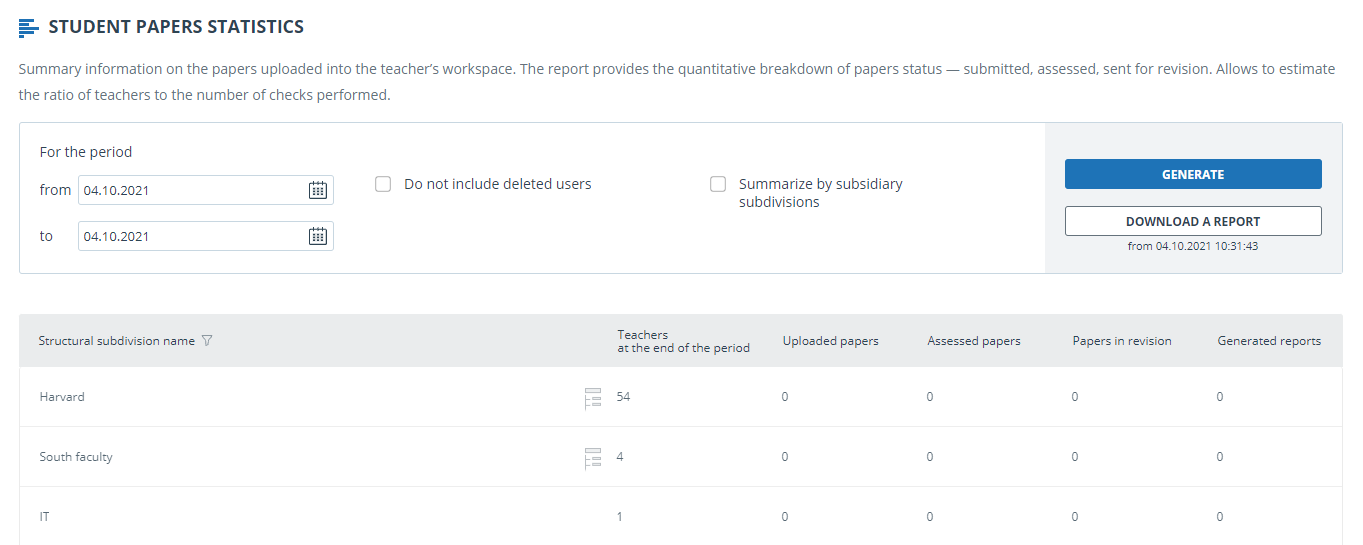
To generate the statistical report, select the time period for which you want to build a report, and click on the "Generate" button.
To view the actual data without taking into account deleted users, mark the box next to "Do not include deleted users".
You can get statistics for each structural subdivision separately, or take into account the results of the subsidiary subdivisions so that the parent subdivision will include the totals for the parent subdivision and all its subsidiary subdivisions. To include the subsidiary structural subdivisions into account, mark the box next to "Summarize by subsidiary subdivisions".
The following metrics are displayed in the generated statistical report:
- The name of the structural subdivision according to the hierarchy established in the company
- Teachers at the end of the period. The number of users with the "Teacher" role created in the company from the very beginning till the end date of the selected interval.
- Uploaded papers. The number of papers uploaded for check during the selected period.
- Assessed papers. The number of papers among the "Uploaded papers" with the "Assessed" status by the present moment.
- Papers in revision. The number of papers among the "Uploaded papers" with the "In revision" status by the present moment.
- Generated reports. Number of text reuse reports for student papers generated during the selected period.
Please note: All attempts of a student to upload a document into one task are considered to be one paper.
Papers uploaded by non-confirmed students are not included in the statistics.
In addition to viewing the statistical report on the website, there is the ability to download a report in csv format. To do this, click on the "Download a report" button.
Detailed report on student papers
"Detailed report on student papers" displays the statistics with the information on each student paper.

This statistic is only available for download. To obtain a statistical report, select the time period for which you want to generate a report, set the filter values, and click on the "Generate" button, then click on the "Download a report" button. The download will start automatically, or a dialog window will open, depending on your browser settings.
The following metrics are displayed in the downloaded statistical report:
- The name of the structural subdivision to which the student’s paper is attached. The paper is assigned a structural subdivision to which the teacher was attached when the paper was uploaded into the task.
- E-mail of the teacher who created the task.
- The name of the task whose duration period overlaps with the selected time interval. The task duration is the period from the start of a task to its end date, and includes both of the previously mentioned dates.
- Document type.
- E-mail of the student who uploaded the paper to the task.
- Paper name.
- Submission attempts. The number of submission attempts.
- Originality. The final originality percentage.
- Current status of paper. Possible status: "Uploaded", "Assessed", "In revision".
- Paper grade.
Statistics for courses and tasks
Statistics for courses and tasks displays quantitative characteristics of the active and completed tasks, as well as the average originality percentage of the paper uploaded into the task, and allows you to get information about the paper submission process by students.

This statistic is only available for download. To obtain a statistical report, select the time period for the set of tasks, whose duration period overlaps with the selected time interval. The task duration is the period from the start of a task to its end date, and includes both of the previously mentioned dates. Then set the filter values, and click on the "Generate" button.
To obtain a statistical report, click on the "Download a report" button. The download will start automatically, or a dialog window will open, depending on your browser settings.
The following metrics are displayed in the downloaded statistical report:
- The name of the structural subdivision to which the task is attached. The task is assigned a structural subdivision to which the teacher was attached when the paper was uploaded into the task.
- E-mail of the teacher who created the task.
- Course name.
- Task name.
- Task code.
- Task start date.
- Task end date.
- Task status. Possible status: "Active" and "Completed".
- Students invited. The number of students invited by the teacher into the task at the moment.
- Uploaded papers. The number of papers sent submitted at the moment.
- Assessed papers. The number of papers among the "Uploaded papers" with the "Assessed" status by the present moment.
- Average final originality. The sum of originality percentage by papers divided by the number of assessed papers.
Please note: All attempts of a student to upload a document into one task are considered to be one paper.
Papers uploaded by non-confirmed students are not included in the statistics.
Statistics on paper originality
Statistics on student papers originality is generated in the format specified by Law No. 667 of the Russian Ministry of Education and Science. It allows one to obtain information on the originality of student papers, which depends on the paper type and selected limits for originality percentages.
Please note: To obtain more precise statistics, you must assign the same document type to all papers that are uploaded into the task.

This statistic is only available for download. To obtain a statistical report, select the time period for which you want to generate a report, set the filter values, and click on the "Generate" button, then click on the "Download a report" button. The download will start automatically, or a dialog window will open, depending on your browser settings.
Filter "originality percentage" specifies the percentage for the comparison of student paper originality with the upper and lower limits. The lower limit defines the number of papers whose originality percentage is strictly less than the specified percentage in the cell "less". The upper limit defines the number of papers whose originality percentage is strictly more than the specified percentage in the cell "more". The lower limit should be smaller than the upper one. If the lower limit is greater than the upper limit, the value in "less" is made equal to the value in the cell "more".
You can get statistics for each structural subdivision separately, or take into account the results of the subsidiary subdivisions so that the parent subdivision will include the totals for the parent subdivision and all its subsidiary subdivisions. To include the subsidiary structural subdivisions into account, mark the box next to "Summarize by subsidiary subdivisions".
The following metrics are displayed in the downloaded statistical report:
- The name of the structural subdivision to which the student’s papers are attached. The paper is assigned a structural subdivision to which the teacher was attached when the paper was uploaded into the task.
- Document type.
- Number of students. The number of students who uploaded paper during the selected interval.
- The average percentage of original blocks in paper. The sum of the originality percentages in the latest uploaded papers (the latest attempt) divided by the number of students.
- The share of papers with originality less than the lower limit. The number of papers that have the originality percentage in the latest attempt strictly less than the lower limit, divided by the number of uploaded papers.
- The share of papers with originality more than the upper limit. The number of papers that have the originality percentage in the latest attempt strictly more than the upper limit, divided by the number of uploaded papers.
Workspace
The Workspace provides an opportunity to upload and check documents. To access the document check, click on the «Menu» and select the «Workspace» section.
On the Workspace page, you will see the «Folders» and «Documents» panels, which are used to perform all the basic actions with the folders and documents of the Workspace.

Document upload
To get started, click the «Check » button. If you have unused checks for Full L and/or Full XL tariffs, a modal window for tariff selection will appear. Select the required tariff and click «Continue». Then select the files on your computer or drag and drop the documents you want to the «Upload documents» field.
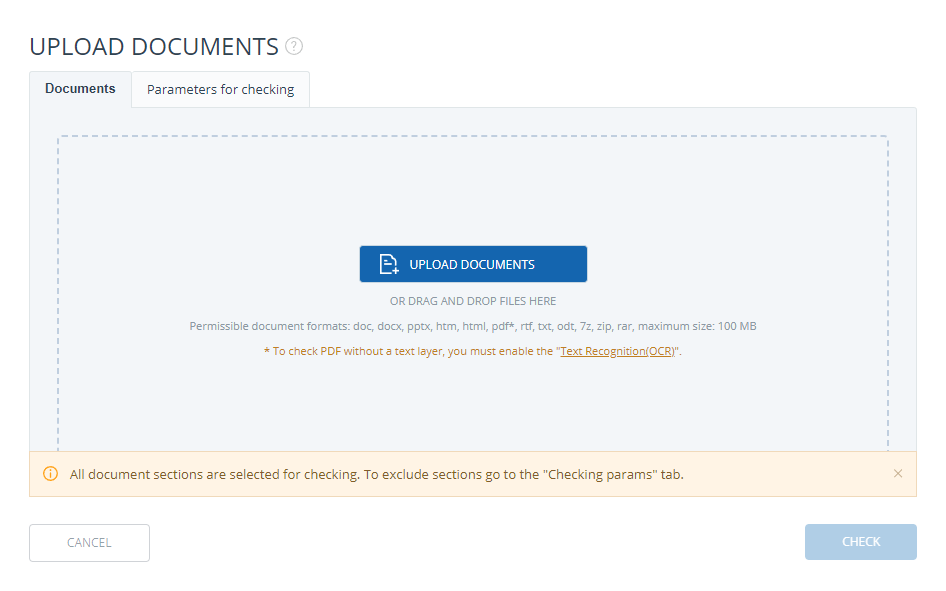
You can exclude files from the list selected for upload by clicking on the icon to the right of the file.

Click the «Check» button to send the selected files for checking.
Please note that system has a limit for the number of symbols in one document. Documents which contain more than 2 million symbols are not checking. After uploading such documents error message will be displayed in Workspace.
Please note that the service supports the most common text file formats: txt, html, htm, docx, doc, rtf, odt, pptx, pdf (including file without a text layer, OCR activation required). The size of the uploaded file should not exceed 100 MB.
Note: A text layer in a PDF is directly text data from a file that can be selected and transferred to another area for further processing as a set of characters, not as an image. A text layer in a PDF can be placed on top of other layers of the file, for example, on top of images. Please note that scans, photos and other images that depict printed characters are not a text layer. To check files containing images with printed characters, but not containing a text layer, you need to enable the Text Recognition (OCR) service
In addition to uploading individual files, it is possible to upload the archive in the format RAR, ZIP or 7z. In this case, all documents from the archive are processed separately.
Please note that it is prohibited to use ;<>=+&%#@[]{}~`®*\ symbols in the name of the document.
If you do not enter the parameters, the following default values will be applied to the document: the folder that was opened when viewing the user's Workspace is selected, the document type is not specified, the name is the file name, all possible check options will be set for the search modules (depending on the services connected by the company).
Document check
After adding files to the list you can specify save and check options of the document and choose the modules which should be checked against the document on the "Parameters for checking" tab.
Documents are checked taking into account the structure, you can include only the sections you need in the check. To exclude a section from the check, uncheck the box next to this section. Detailed information on each section will be available on the "Check Results" page in the "Document Structure" tab.
OCR - optical character recognition. The service allows you to check the text that is visible when viewing the document, but which is not a text layer (such text cannot be selected with the mouse). If the document contains graphic images with text data, they will be recognized and checked for originality.
Please note that when checking with OCR, the processing time of the document may increase. With OCR only the first 1000 pages of the document are checked. The remaining pages will not be processed.

Next, click on the "Check" button, the document will be added to the Workspace and sent for check. In the folder where the document was added, you will see the added document, in the line with the document will be the date of loading the document. After the check is complete, the check results appear in the row.
Text check
In some cases, it is more convenient and faster to use the text check function, click on the "Add text" button. In the form that opens, type or paste in the text field, select the collections that will be used to check the document, and then click "Check".

After you click "Check", a document will appear in your workspace, its name will be the same as the first word in the entered text (no more than 15 characters), and then a check for this document will start.
Document recheck
If you want to check an uploaded document through other collections, you can use the recheck option. Mark the selected document, then click on the "Recheck" button in the top menu.

In the dialogue window, select the search collections and click "Check".
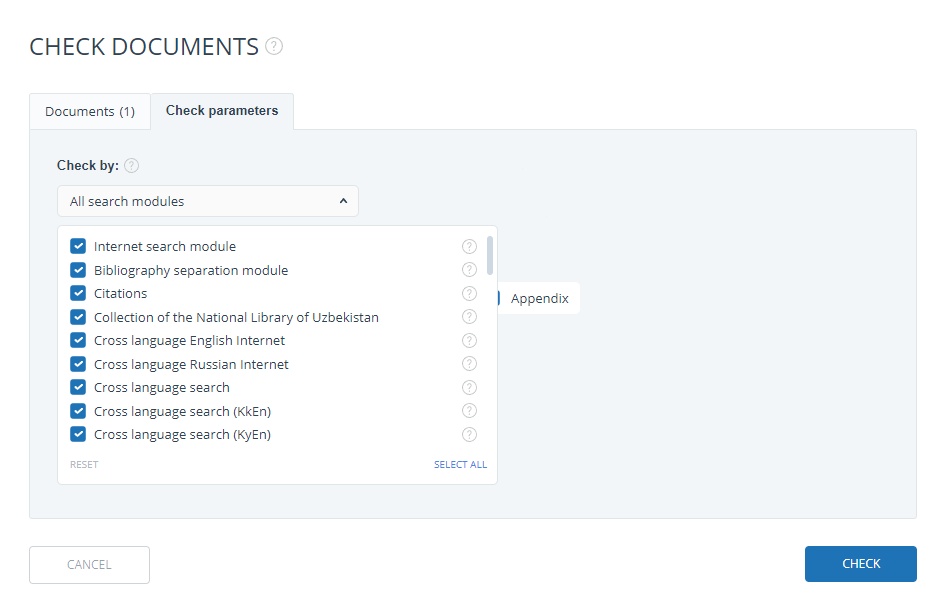
We recommend that you do not perform repeated checks on the same collections as in the previous checks: most likely, the result in this case will be identical.
The document will be sent for check and after a while the results will appear in the line with the document. It is impossible to send the document for rechecking, if it is in the process of checking.
Viewing and editing document information
Each document when added or moved to the Workspace is placed in the folder of the Workspace. Once you click on the name of the folder in which there are documents, you will see the documents contained in the respective folder.

Documents are arranged in a list. Each row in the list displays information about the document, the result of the check, and a link to the report.
The originality assessment in the document line is intended for the primary, superficial acquaintance with the results of the check. To get a detailed assessment of the results of the test, go to the scan report view by clicking on the "See results" button. After that select "Full Report".
To view the information about the document, open the folder, click the "See results" button located next to the document. After that select "Document statistic". A window will open with the document attributes and information about the date and duration of the upload.

To view the text of the uploaded document, click its name in the list of documents. The "Version for reading" page opens, displaying the text of the document in page-by mode.
To navigate through the text pages, use the paging panel located above and below the text box. You can display all pages of the document at once by clicking the "Show all pages" button under the text field.
On the tabs "Initial view" and "Annotation" you can see the text of the loaded document with the original formatting and annotation to the document, respectively. An annotation to the document is automatically generated by the system and consists of several sentences from the document to get an idea of its content.
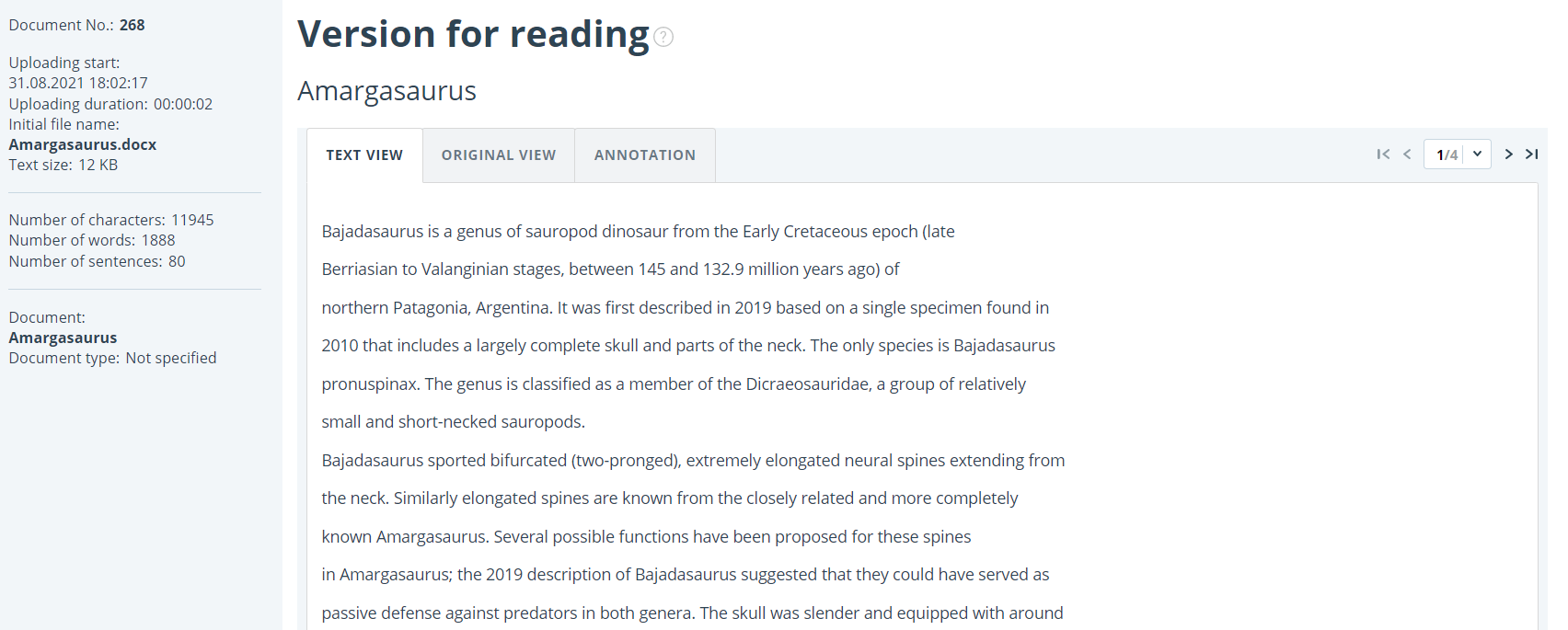
The same operation can be performed by selecting the desired document in the Workspace and clicking the "Change name and type" button in the top menu. In the window that opens, you can change the name of the document and assign a document type.
Automatic extraction of author's name
The "Antiplagiat" system attempts to extract the name of the author(s) from the text when loading a document. In case of successful extraction, the full name of the author(s) is displayed on the "See Results" page in the "Document Properties" section after the document is loaded and checked.
To go to the "See Results" page, click the "See Results" button near the necessary document in the Workspace.
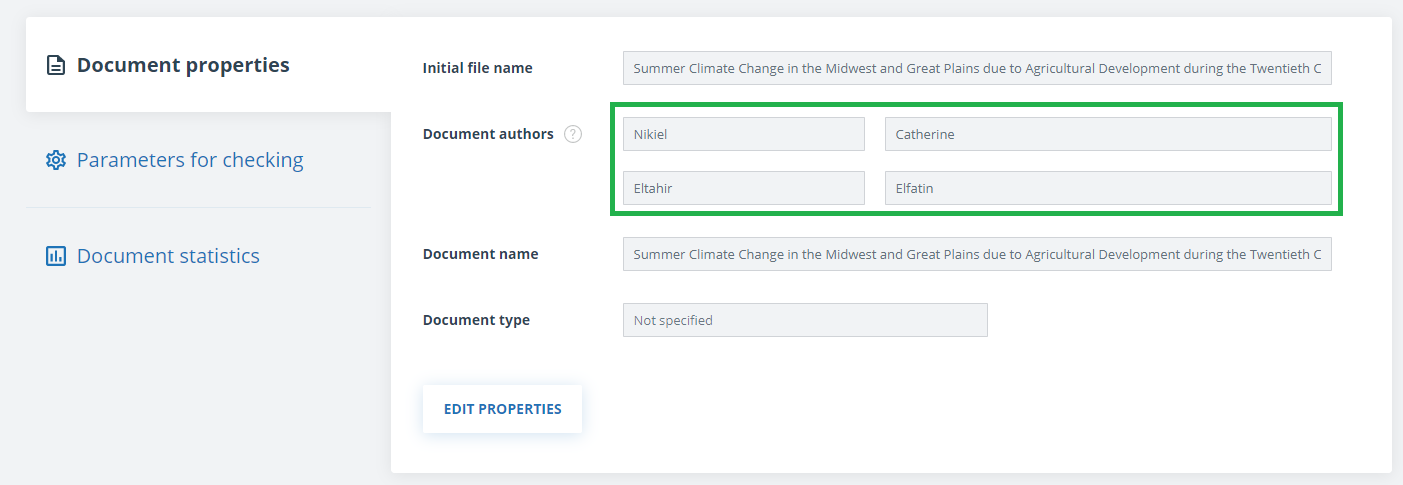
The system extracts up to 10 authors. The extracted authors are used to automatically calculate the indicator "Text recycling". Automatic calculation of the Text recycling percentage will be made within the eLIBRARY, RSL and NLB collections.
If the system has not extracted any author of the document, then in the document properties the "Document authors" fields will be highlighted in yellow. In this case, enter the author's name manually (see Manual adding the name of the document's author). The authors' names are required to calculate the indicator "Text recycling", and are also used to display information about the authors in verification certificate, printed and pdf-versions of reports.

Manual adding the name of the document's author
You may add the name of the document's author after checking the document. Сlick the "See results" button located next to the document and select "Edit properties". After that add the author of the document. You may add up to 10 co-authors.

After setting the author's name, the automatic process of text recycling percentage calculation will be started. You may correct the text recycling percentage manually by changing the types of sources.
Automatic calculation of the text recycling percentage will be made within the eLIBRARY, RSL and NLB collections.
Moving a document
To maintain the hierarchical structure of folders, use the "Folders" panel, displayed on the left in user Workspace. The "Folders" panel contains active items and buttons that allow you to perform actions on folders: add, delete (if the folder contains documents, they will be deleted), rename and move the folder, and navigate through the folders.
By default, a "Root folder" is automatically created in each Workspace, all other folders are created in it, this folder cannot be deleted, moved or renamed.
To the right of the folder names you will see a numeric value – this is the number of documents in the folder, so you can additionally control the distribution of documents by the folders.
To move a document from one folder to another, mark the document with a checkmark (you can select several documents to move), then click the "Move" button in the top panel.
The dialogue window will be opened; it will display the folder structure. Select the destination folder and click "Continue", then the document will move to the selected folder.

Document search
To search for a document, enter the full or partial name of the document in the search bar, and then click on the button in the form of a magnifying glass or the Enter key.

After the search is started, the list of documents will show the found documents in all the folders that are nested inside the root folder. You can navigate folders by leaving a request in action, then only documents on request will be visible in the folders.
Document deletion
To delete a document from the Workspace, tick it and click on the "Delete" button in the top panel.

If you are a corporate user, the document will be deleted from your Workspace, but will remain in the collection of the company with the mark "Deleted". The administrator of the company can restore the document deleted from the Workspace through the collection.
Reports' history viewing
When you recheck a document or edit a report, all previous versions of reports are saved in the system. To view the history of reports, select the document and click on the “Report History” button on the top panel.

You may see a brief information about all the reports created on this document in a separate opened window. Reports in a history are sorted in descending order of date.
To move to a detailed view or adjust one of the reports, click on the "Open" button. The report will open on a new page.
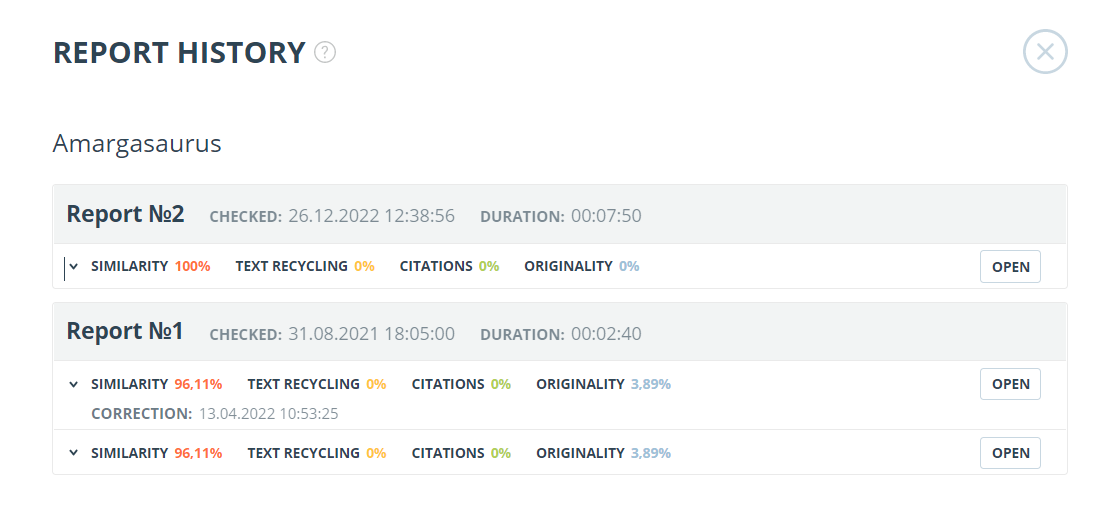
You may also see all the corrections of the report and edit the specific correction. A correction is created automatically after the report is edited.
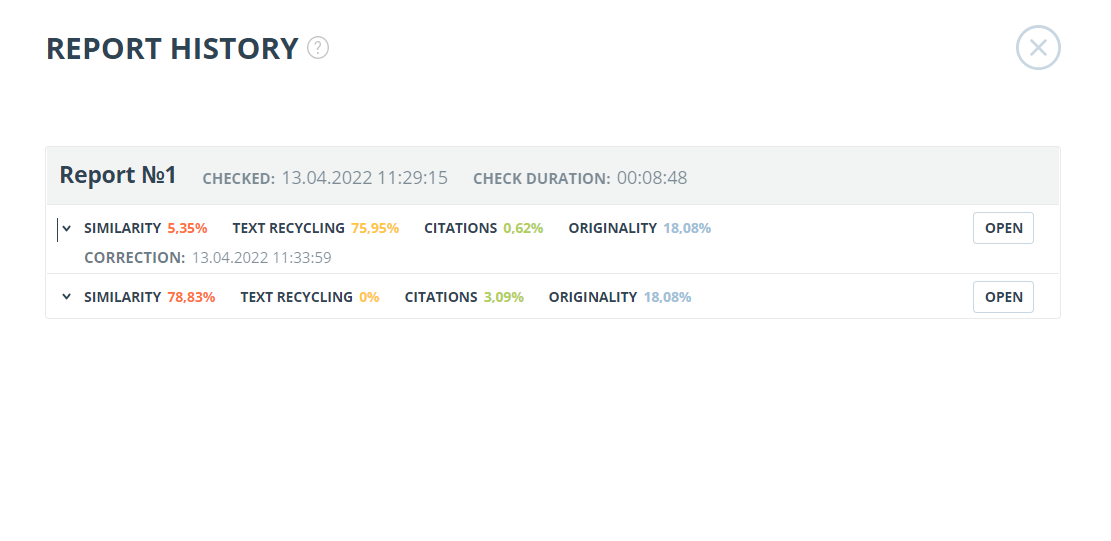
Text metrics
On the check results page, on the "Text Metrics" tab, you can see various semantic characteristics of the document.
Please, pay attention that Metrics are calculated only for new documents. For documents uploaded before enabling this functionality, the calculation is not performed.
The block of text metrics is divided into the following components:
- Document rubrication
- Semantic characteristics
- Named entities
- Phrase segmentation
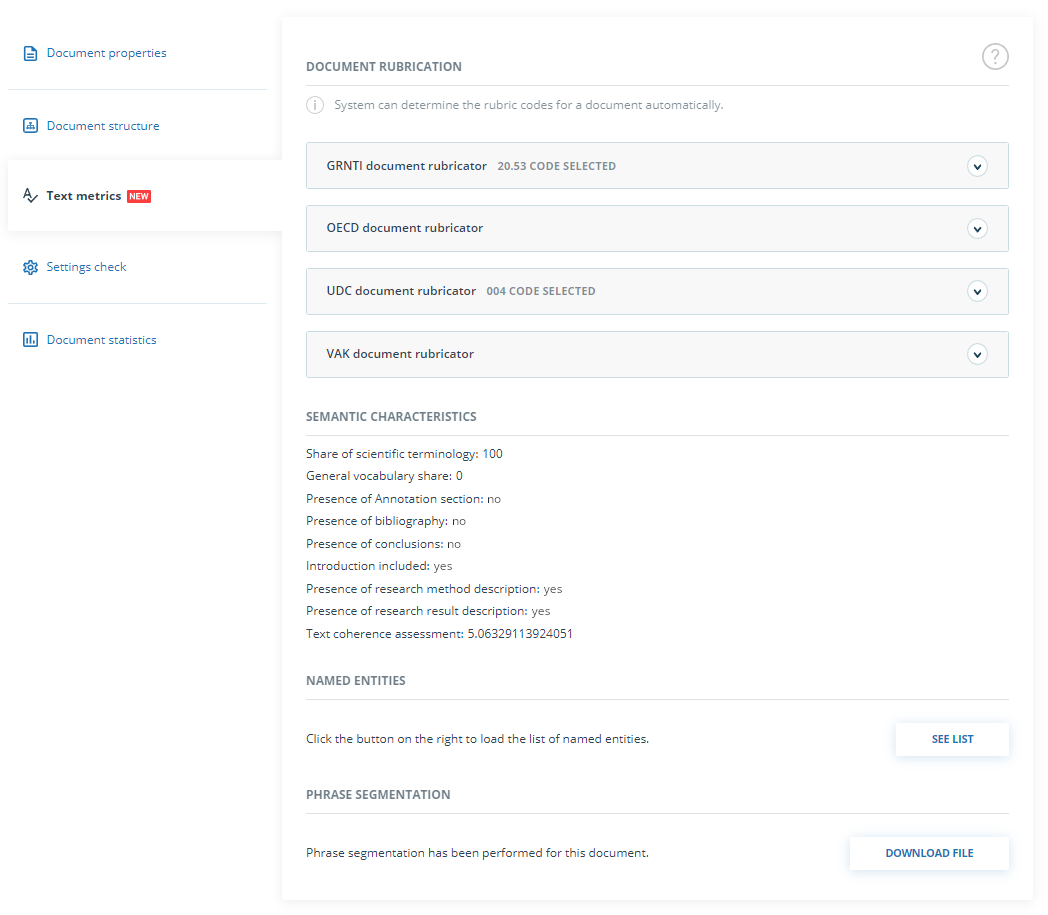
Editing document rubrication codes
After uploading the document to the system, you will be able to edit the codes of the categories of universal classifiers that allows you to attribute the work to a particular field of knowledge.
Automatically defined codes for each category are grouped into collapsed lists.. To expand and view the list, click on the button on the right side of the field with the name of the category.

To confirm one of the codes automatically determined by the system, click the "Confirm" button to the right of the desired name.
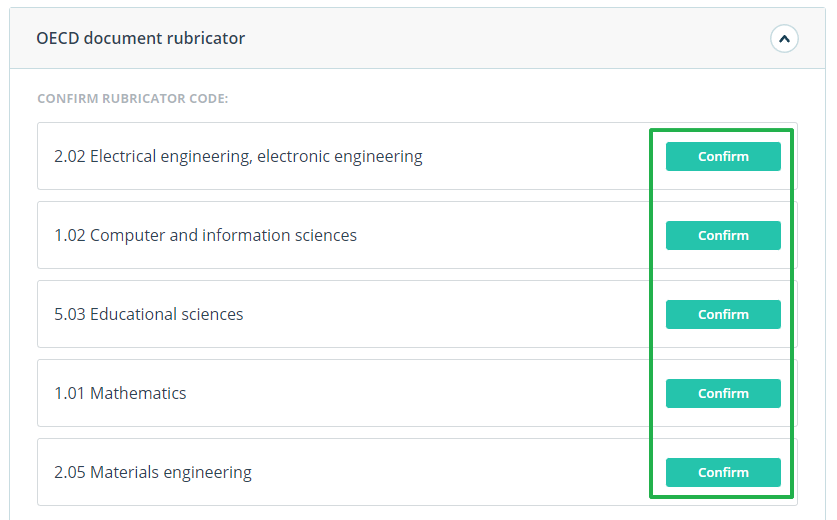
If no code has been determined automatically or there is no necessary code among the proposed codes, add it manually using the "Select from the full list" field at the bottom of the rubricator list. To do this, start by entering the name of the category.

To confirm the selection, click the "Add" button to the right of the selected code.

The selected code is displayed next to the name of the category. To reset and change the selected code, click the "Reset" button to the right of the name of the previously selected category.
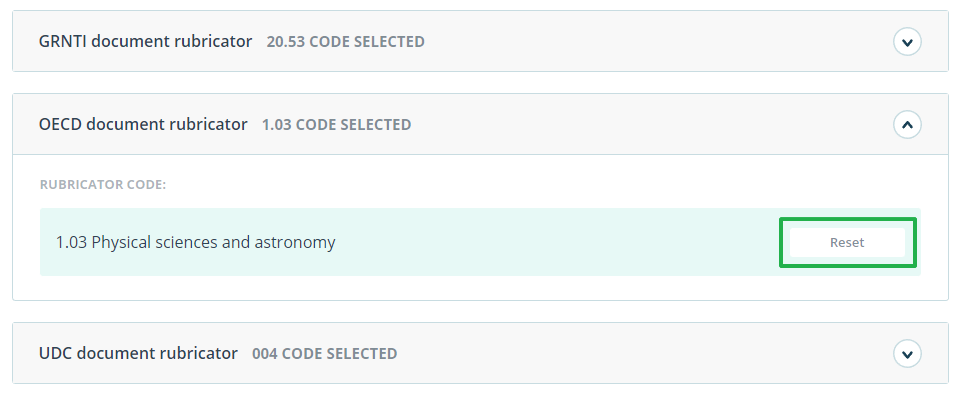
When the code is reset, you will be able to select the category again from the suggested list or specify it manually.
Semantic characteristics
The system calculates and displays of various semantic characteristics for each uploaded document. This functionality allows you to evaluate the scientific nature of the text, determine the presence of special sections in the document, and calculate some indicators. The calculation takes place automatically when the document is loaded.
List of calculated semantic characteristics:
- The share of scientific vocabulary. The indicator is from 0% to 100%, where 100% corresponds to a completely scientific text, and 0% corresponds to a completely unscientific text. The indicator is the ratio of words and phrases, included in «the dictionary of scientific terms and constructions»to the total number of words and phrases in the text being checked.
- The share of the general vocabulary. The indicator is from 0% to 100%. The formula used to calculate is (100% - [Share of scientific vocabulary]).
- The presence of an annotation.
- The presence of conclusions.
- The presence of an introduction.
- The presence of a research method description.
- The presence of a study results description.
- Assessment of the coherence of the text. The indicator is from 0% to 100%, where 100% corresponds to perfectly connected text, and 0% corresponds to completely disconnected text. The coherence of the text is characterized by the syntactic and semantic coherence of its sentences. When determining the coherence of the text, an error may occur due to the document being checked using OCR and the presence of images in the document being checked.

Named entities
To get a list of named entities, click the "View list" button in the "Named Entities" block.
A modal window opens, which displays a list of named entities as well as information about the number of named entities found in the document. Each named entity is located in a separate block.
For each named entity, entities are compared in various languages. To open a list with mapped entities, click on the arrow.

If an error occurs when forming a list with named entities, it will be displayed in the modal window.
Phrase segmentation
To view the list of segments and semantic units of the downloaded document, click on the "Download file" button. An XML file will be produced. Depending on your browser settings, the download will begin automatically, or a dialog box will open to allow you to download and save the file.
In the uploaded XML file, you will see your uploaded document presented as a list of segments. After the list of segments, a list of semantic units will be presented.
Adding documents to company's collection
If you want carry out text reuse detection in your company with the uploaded documents, you may add your documents to your company’s collection.
To add documents to the collection, select documents and click on the "To Index" button.

You may delete your documents from the company's collection. Select documents and click on the "From Index" button.
The report on the text reuse check result
Full report
After the document is loaded and checked, you may navigate to the report. To go to the full report view page, click the “See results” button located on the line with the checked document. After this click "Full report" button.

The full report includes:
- evaluation of originality / similarity / quotes / text recycling;
- evaluation of suspiciousness of a document with details on the "Suspicious document" page
- list of similarity sources with the ability to edit and go to the source report;
- continuous or page-by display of the full text of the document marked with the found similar blocks;
- page-by-page display of the full text of the document in the original document;
- the date of document checking;
- document's name;
- report correction.
The figure below shows a General view of the full report.

In the top panel of the page you will see the icon buttons, allowing you to proceed to the next action:
- parameters for checking;
- export of the report;
- downloading the Certificate;
- save the edited report;
- report printing layout;
- view reports history;
- view text metrics;
- get a direct link to the report;
- link to the brief report;
- link to user manual.
Viewing the report
The report page consists of the text to be checked, in which the similar blocks are highlighted, the list of sources, the aggregated results of the check and navigation through the blocks of similarity (search by blocks).
To navigate through the text pages, use the paging panel located above and below the text box. To display all pages of the document at once, click on "Show all pages" at the bottom of the document page.
To return to the page-by-page display of the report text, click the "Show by page" button on the paging panel.

To see which text fragments were similar and to which specific source, all text similar blocks in the system are highlighted, and at the end of each block there is a label with the respective number of the source.
When viewing similar blocks in a report, you can use block navigation (block search). With its help you can go to the next or previous block by pressing the "Previous" or "Next". You can also choose which type of text blocks to use.
Viewing information about the source
To view information about the source, find the source in the list, expand the respective source and click on the icon.

The source information window displays various data on the source: a link to the source, the date of its publication, the author, etc. The list of fields may be different depending on the search module and the source itself. An annotation to the source is also displayed in the source information menu. Annotation is an automatically generated short piece of text from a document to form an idea of its content.

If the source is placed in index of approved by administrator of your company, then appropriate flag about the source appears. Text reuses from such source included in citing percentage and highlighted by green color.
Parameters such as text share, report blocks, text blocks are customizable. To do this, click on the "Menu", select the "Profile" section and go to the "Report settings" tab. You can choose which of the parameters will not be displayed in the report by unchecking one of them.

When analyzing sources, you can use both report share and text share. For a clear understanding of the difference between them, let's give an example: The report indicates two sources "Source A" and "Source B". According to the sources, the same paragraph of the text was found, which makes up 10% of the total volume of the document being checked. In this case, we will get the following data:
- Source A: text share is 10%, report share is 10%;
- Source B: text share is 10%, report share is 0% (because this text has already been taken into account from source A.)
Another way to view information about a source is to click on the source number in the full report text. A window will appear that contains basic information about the source.

External link to the source
For most sources in the list there is an external link to the location of the document or source text on the Internet. To go to the web page, click the icon next to the source name.
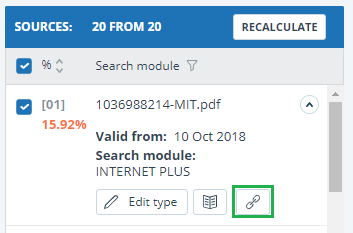
After clicking on the link, the web page on which the text of the block was found will be opened.
A situation may arise when the source is unavailable after clicking on the link. Perhaps the site administrators deleted the text, or the page "moved." But in any case, this text was available at the specified address when the site was added to the index of the search module of the system.
The fact that one or more of the report's links to the open sources on the Internet at the time of viewing the report do not work is not a reason to remove these links from the system's index. Texts at the links' addresses were indexed, before being deleted / moved, they were available to third parties, could be read, copied or otherwise used. Also, they could be stored in the cache of search engines and web archives, where they could still be found.
Viewing the source report
To view the source report, click the link in the source name in the list of sources. A new tab in the browser will open with the text of the source with which there was a duplication. Instead of text that doesn't overlap with the source, you'll see the number of characters that were skipped.
If you want to view the full source text, open the source link by clicking on the "Go to the source website" button.

Click another source in the Sources pane on the left to view the report for that source immediately.
You can choose to view the report by source – page or solid text. By default, the source report is displayed page by page. To switch the view mode, click on "Show full text". When you switch to solid text view, the button changes to Show text page by page. Click it to go to page view.
Another way to view the source report is to go to the source report from the block in the text. Click on the source number at the end of the block, then click on the source name.
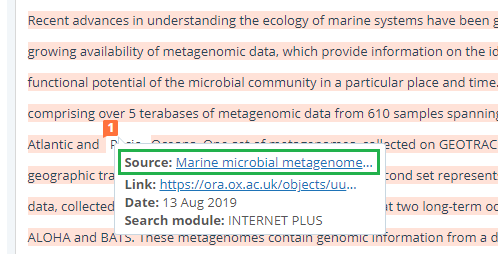
The page "Report on the source" will be opened with the selected block.
Viewing report history
When you recheck the document or edit the report, all previous versions of the reports are saved in the system. To view the report history, click the "More" button and select the "Report history" item in the top menu of the full report.
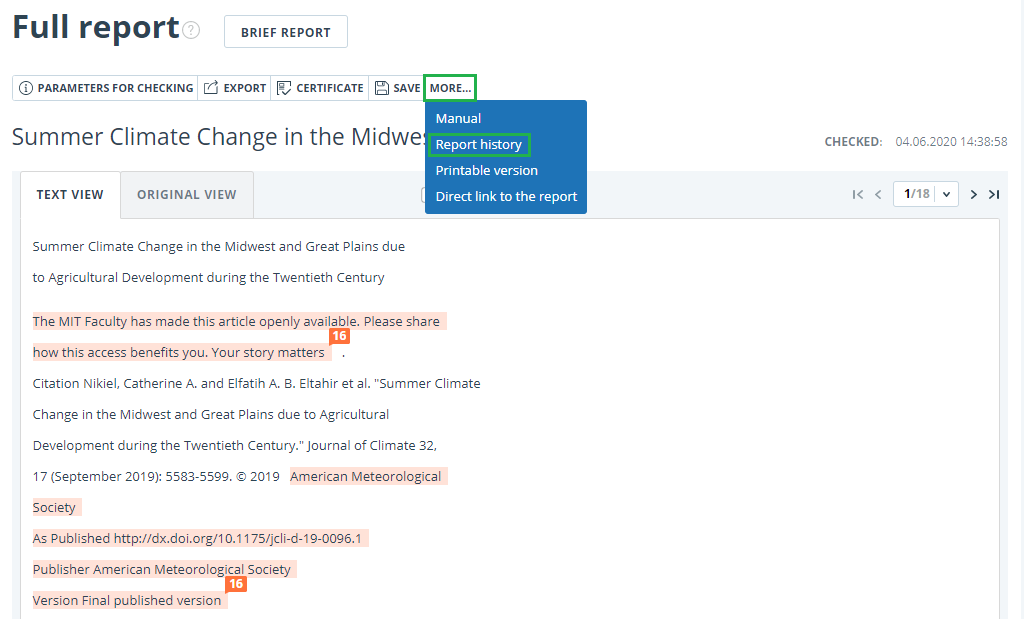
A separate window will open, where you will see a summary of all the reports made for this document. Reports in history are sorted in descending order by the build date.
To go to the detailed view or correction of one of the reports, click the "Open" button. The report opens on a new page.

You can also view all the corrections to the report, go to a specific correction and change it. The correction is created automatically when you edit the report.

Editing of the text blocks
You may adjust the check result not only by excluding or changing the source's type, but also by deactivating text blocks. This feature allows to not use the selected blocks when calculating the percentages.
To disable the necessary text block in the report, left-click on it. The “Deactivate” button will appear. After this the block will change color to gray. The system will automatically recalculate the percentages, but without accounting disabled text block.

To take the disabled text block into account again, find the disabled text block and click on it. The “Enable” button will appear. After clicking on it, the result will be recalculated again.
You may find out if there are the disabled text blocks and enable all the text blocks at once in the check results panel. To enable all text blocks, click on the “Enable All” button and the system will automatically recalculate the check result.
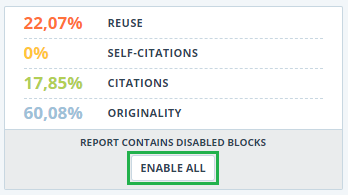
Also you may find out if there are any disabled text blocks in the workspace. In the list of documents a report that contains disabled text blocks has one more status : "The report contains disabled blocks".

Please note that text blocks of different sources may intersect with each other - one smaller block may be the part of the bigger block. After deactivating a large text block, the small text block will be deactivated with it.
You may use navigation on disabled blocks to the right of the report's text.
Comments to the report
On the full report page in the original view mode, you can make comments to the report. This functionality is not available in a text view mode. The comments button is located at the top panel of the page. The current number of comments to the report is shown in parentheses next to it. When you click on the button, a drop-down list of suggested actions opens. You can leave your comment and view all comments.

As you scroll down the document, the comments button moves to the right corner next to the page switching.

Adding a comment
When you click on "Create Comment", the mouse cursor changes to a special indicator of document areas where you can leave comments. In some areas of the document, the cursor may become translucent and colorless, which means you cannot leave comments on this area. A special mark is set at the place of the click, and a text box opens next to it. A comment length is limited to 250 characters.
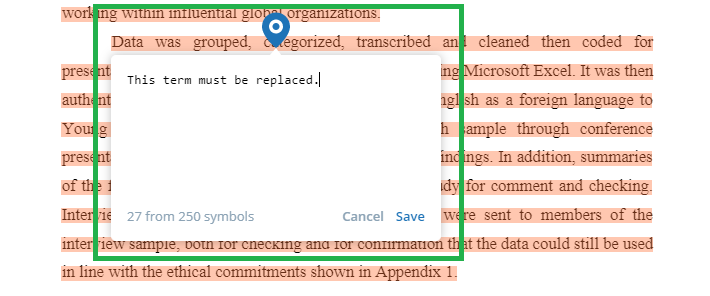
When you save a comment, a comment icon appears near the place where you made the mark.
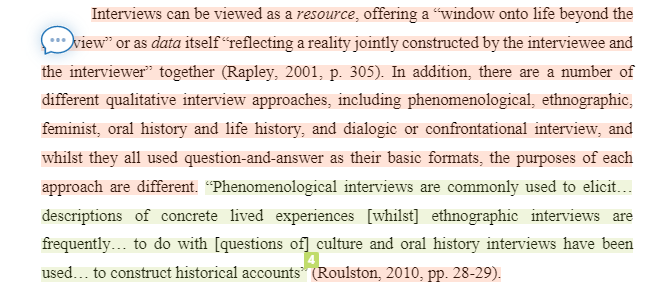
If you change your mind about creating a comment, you can click anywhere outside the comment, or click the "Cancel" button in the text box, and it will disappear. After that, the cursor will become standard. To re-comment, click the comment button at the top panel of the page again and select "Create Comment."
Actions with comments
Each user with the rights to comment can do the following:
- Viewing;
- Editing;
- Deleting.
You can edit your comments. To do this, click the "Edit" button, make changes and click the "Save" button. If you want to delete your comment, click the "Delete" button and confirm the deletion.
View all comments
To view all comments at the report, click on the comments button at the top panel and select the "View all comments" option in the drop-down list. You will see a modal window with a list of comment links. A comment link displays a full text of the comment in the report. Viewed links are highlighted in grey.
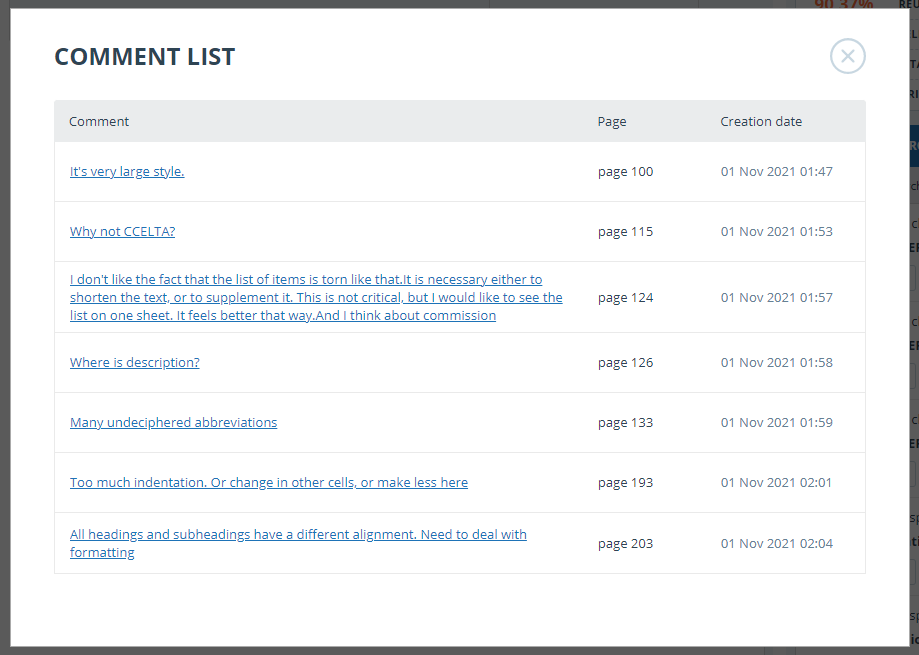
You can click on the comment text only. After the click, the modal window with the comments list will close, a page with the comment will display and a textbox with the comment will open on the page.
Access by a direct link
A direct link to a report displays all comments in a read-only mode. You cannot create and edit comments even if you are logged in to the system.
Editing of the sources' list
When viewing the full report, you can, if necessary, to perform the following actions with sources:
- Changing of source type;
- Source exclusion;
- Source recovery.
To manage sources, you can click on the icons in the block on the right side of the full report page.
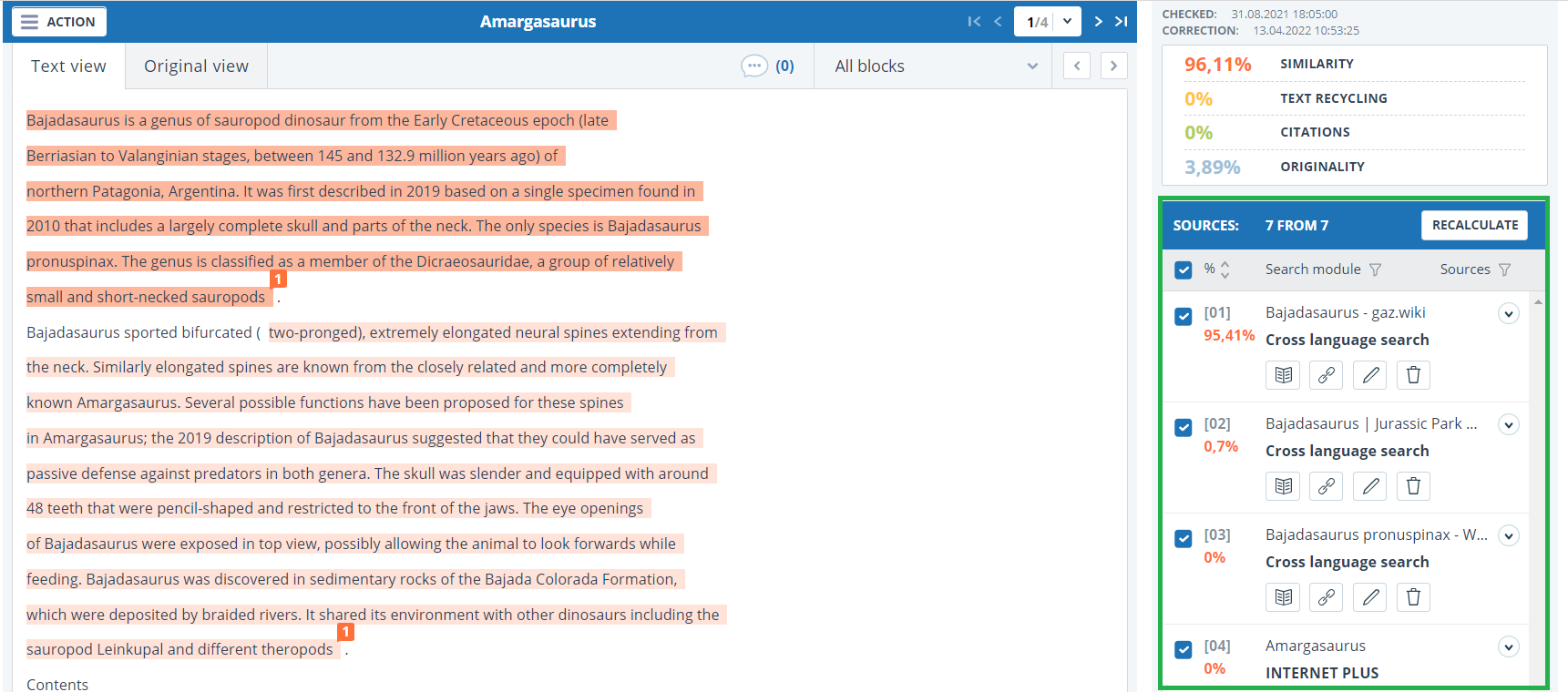
Changing of source type
To change the type of source, you need to click on the "Pencil" icon.
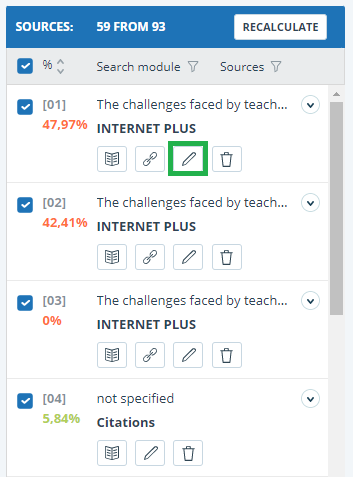
Clicking on the icon will open a modal window for detailed correction of the source type. In this block, it will be necessary to indicate the new type, the reason for changing the source and your comment on the changes.
The list of reasons depends on the selected source type. For each of the reasons, there is a tooltip that is visible when hovering over the question mark. If you did not find a suitable reason, you can select "Other", but with the obligatory indication of a comment.

The reason and comment will be displayed in reports and printed forms.

Source exclusion
To exclude a source, you need to click on the "Trash" icon.
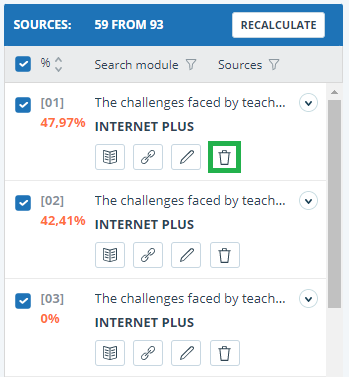
When you click on the icon, a modal window will open to confirm the action with an indication of the reason and a comment. It is obligatory to indicate the reason.

Source recovery
If you need to restore an excluded source, first, in the block on the right, you need to filter the sources by their status. To do this, in the filter panel, select "Sources" and select "excluded sources" from the list. The content of the block will be reloaded, instead of the exclude icon, the source restore icon will appear.

When you click on the restore source icon, a modal window for confirming the action will open.
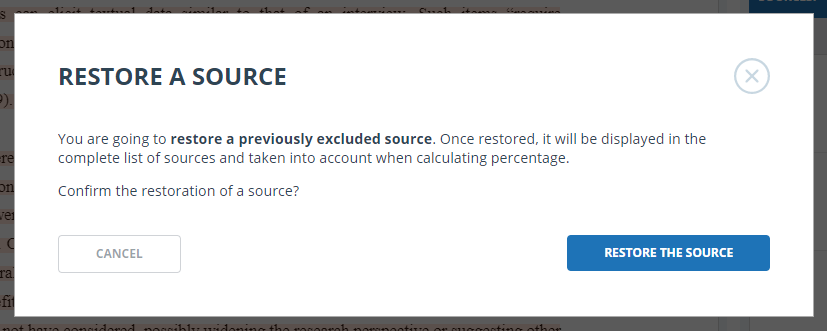
Upon confirmation of the action, the source will reappear in the list of active ones.
Editing text similar blocks
You may adjust the result of the check not only by removing the source, but also by disabling individual similar blocks in the text. This allows you to ignore the selected blocks when calculating the percentage of text similarity or quotation.
To disable the particular block in the report, click it with the left mouse button. The "Deactivate" button appears. After clicking the "Deactivate" button, the block will change its color to gray. The system will automatically recalculate the percentage of text similarity without taking into account the block you have turned off.

To restore the block in the report, find the disabled block and click on it. The "Enable" button appears. Click on it, and the result will be recounted.
You can see if there are any blocks off, and include all the blocks in the results panel at once. To enable the blocks, click the "Enable all" button, the system will automatically recalculate the result of the check.

If any report has disabled similar blocks, you can find out about them in your workspace. In the list of loaded documents, the report, which contains the disabled blocks, has another status "The report contains disabled blocks".

Please note that the blocks from different sources can overlap – one smaller block may be the part of the larger block. If you deactivate a larger block, the small block will be deactivated as well. Moreover, the shutdown of the small unit will occur on all sources to which it is included.
If the blocks intersect partially, only those fragments of the block that are not included in the intersection are disabled.
To save time when viewing disabled blocks in a report, use the navigation in the menu at the top of the report text. Click on the "All blocks" button. A navigation window will appear. Select "Disabled blocks". With it, you can go to the next or previous block by clicking on the left ("Previous") or right ("Next") buttons.

Brief report
To go to the brief report view page, click the “See results” button located on the line with the checked document. After this select "Brief report" button.
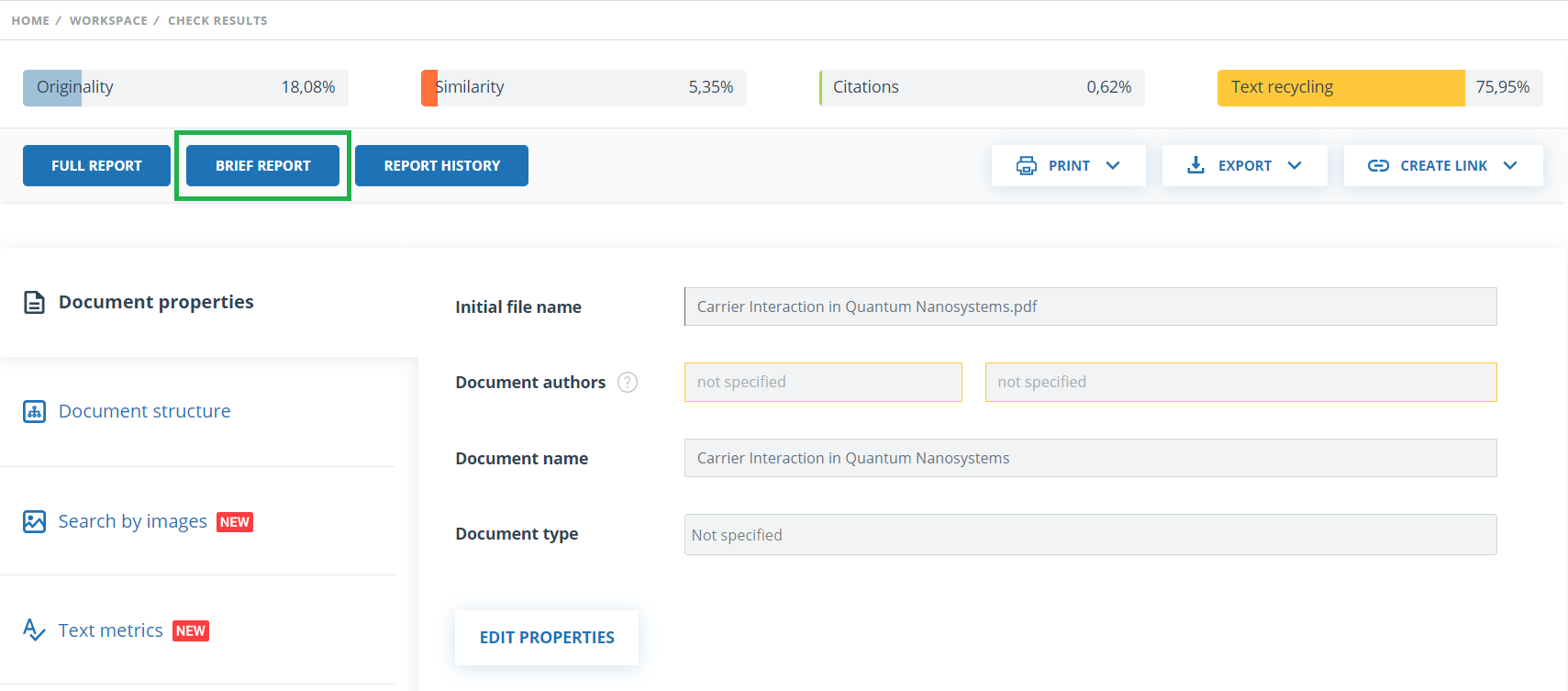
Brief report consists of distribution of percentages of originality, text similarity, quotes and text recycling as well as a list of similarity sources.

For most sources in the list there is an external link to the location of the document or source text on the Internet. To go to the web page, click the icon next to the source name.

In the top panel of the page you will see the icon buttons, allowing you to proceed to the following actions:
- parameters for checking;
- export of the report;
- downloading the Certificate;
- save the edited report;
- link to user manual;
- view reports history;
- report printing layout;
- view text metrics;
- get a direct link to the report.
To get more information about the results of the check, open the full report by clicking on the "Report" button.
Report with formatting
A formatted report allows you to view the results of the document check while maintaining the original formatting (indentation, fonts, titles) and displaying tables and figures.
To view the report with the formatting, switch the tab "Text view" to the tab "Original view".
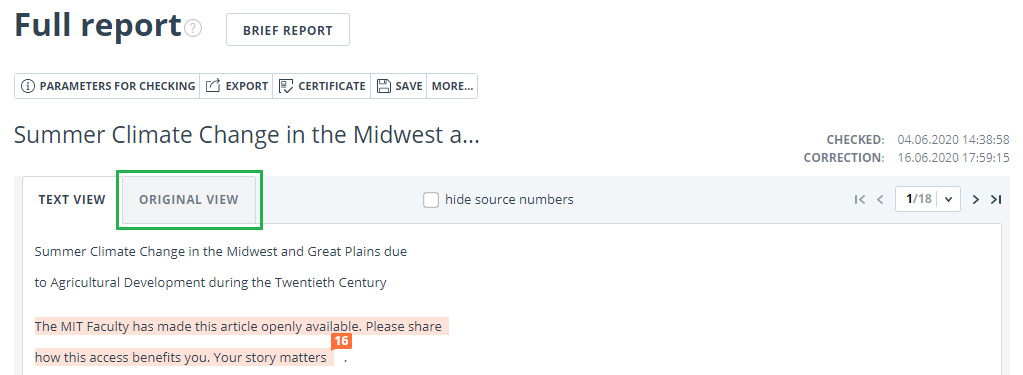
The Original view tab, as well as the Text view tab, displays reused parts and a list of sources, but the markup is applied to the original formatting of the document.
It is worth noting that when you export the pdf report, the text of the document is downloaded without any formatting.
You can view the document in its original form in the "Version for reading". To do this, click on the name of the document in your account. The text view of the document opens, then click the "Original view" tab.

Please note that when adding for check files in txt, htm, html, pptx format, direct text input, you cannot view the original formatting of the document.
Document Structure
You can find sections of the checked document on the check results page in the "Document Structure" tab. The structure is extracted automatically while document is being checked for similarity.
Here you can see information about the following sections:
- Title page;
- Content;
- Main part;
- Bibliography;
- Appendix.

The following information is provided for each section:
- Whether it has been included in the check or not;
- The number of pages in the section;
- Page numbers for each section;
- Section’s text share compared to the text of the entire document
If a section has not been found by the system, a special notification will be displayed.
The block on the left shows a diagram of the document structure. Each section is marked in its own color. The sequence of the sections on the diagram reflects the sequence of the sections in the document.
When you click on the "Document Structure" button, a detailed analysis of the document divided by structure opens in a new tab.
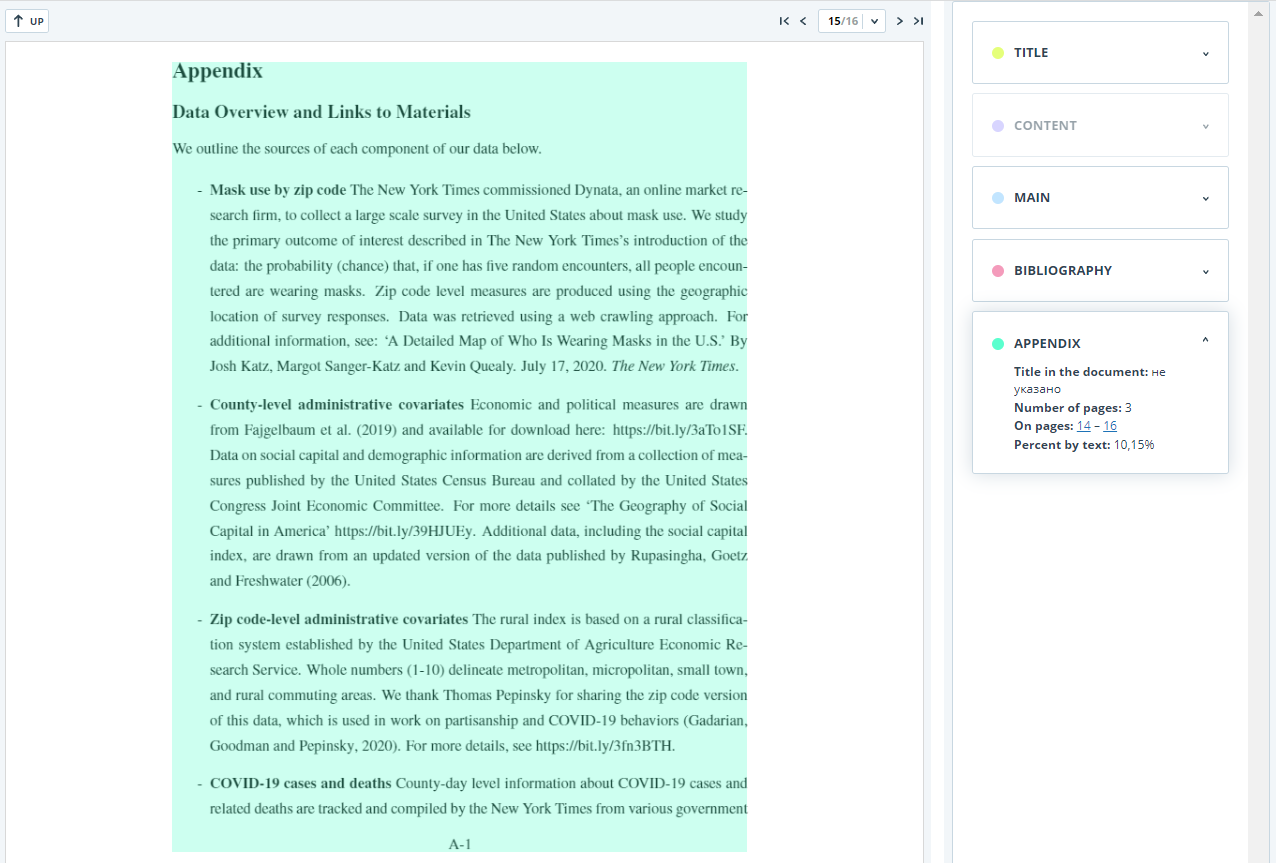
The panel on the right contains blocks with the sections. When you click on the block, you can see the information on the particular section. Clicking on the page number takes you to the respective page of the document. The text in the document is highlighted by the color of the corresponding section.
On this page you can edit the structure of the document recognized by the system if you see any errors. The following actions are available to you:
- adding a section;
- changing the borders of a section;
- deleting a section.
Adding a section
To add a new section that was not recognized by the system automatically, you need to open the menu for the desired section and click the "Add section" button.

After clicking this button, you will need to put markers for the beginning and end of the section being added. The start marker appears first. It should be placed on the first line of the section in any place. After setting the start marker, you need to put the end marker on the last line of the section in the same place. If everything is put down correctly, click "Apply" to complete the markup of the section.

Changing the section borders
You can edit the borders of an existing section. To do this, click on the "Change borders" button near the beginning or end of the section. Then you can left-click on the marker that you want to move. With the next mouse click, you can set the marker to a new position. When you are satisfied with the changed section borders, click "Apply" to complete the editing.

Deleting a section
You can also delete a section if it was identified incorrectly and needs to be removed. To do this, click the "Delete section" button at the beginning or end of the section. Please note that you cannot delete the "Main part" section, since it is mandatory.

Saving changes and refreshing check results
After making changes to the structure of the document, they need to be saved. To do this, click the "Save" button at the top of the screen.

Please pay your attention that after saving the changes in the structure, they are not automatically applied to the report. In order to see the results of checking the document with the updated structure, you need to recheck the document. For more information, see Document recheck
Suspicious document
A suspicious document is a document that shows signs of technical ways to change the text or format, such as replacing characters, inserting invisible text, etc. Such signs may indicate that the author tried to cheat the system to hide text reuses and artificially increase the originality percentage. If such signs of cheating have been found in the document, a special flag will be put for it in the workspace and the list of documents of the company.

Please note that if you see a suspicious flag, we recommend that you carefully read the check report and the suspicious fragments found in the document. Detection of suspicious documents is an auxiliary tool for analysis. The final decision is always up to the verifier.
The information that the document shows signs of a cheating is displayed in the check reports, in the printable versions, and in the downloaded reports. In a brief report the page numbers with the detected potential cheating attempts are displayed.
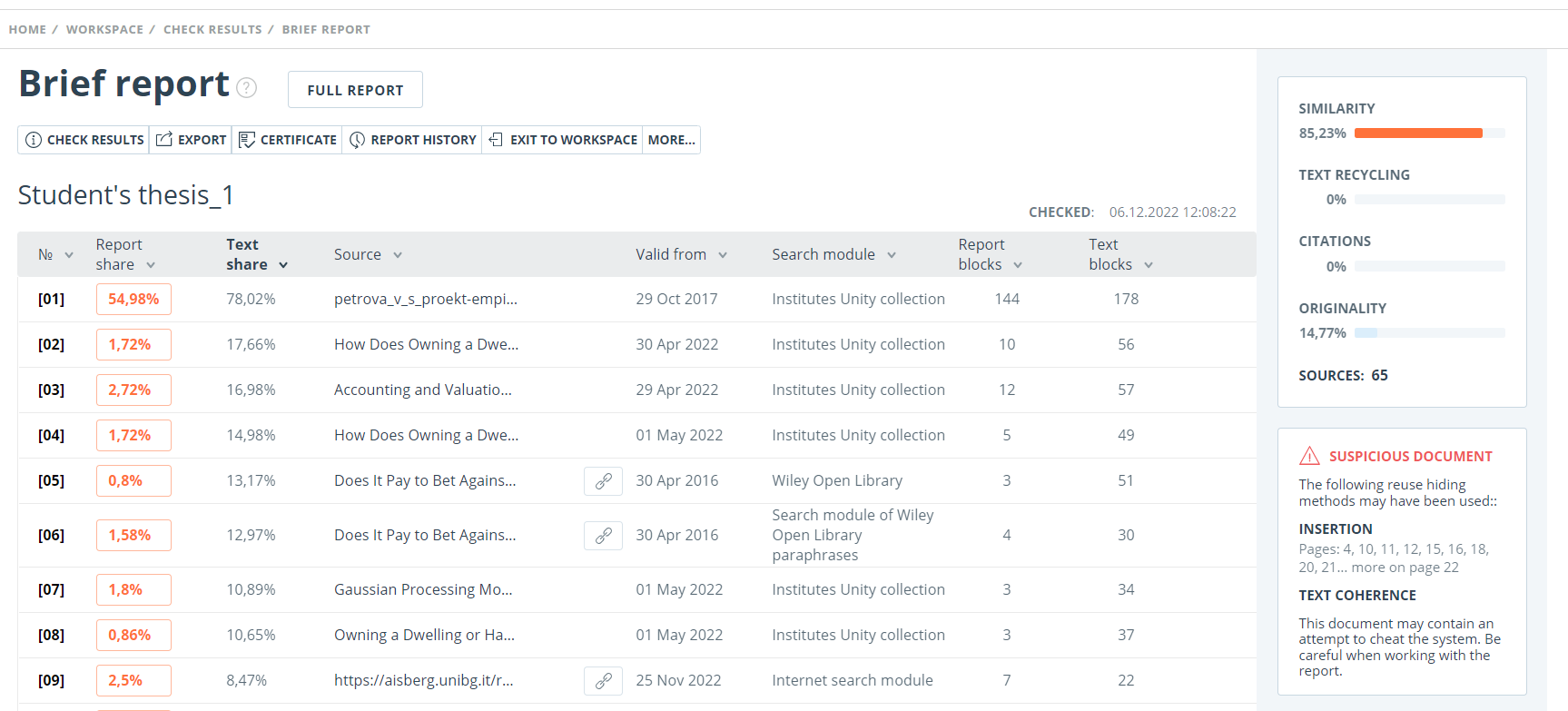
The printable version of the check report provides information about potential cheating attempts. It shows the types of cheating and page numbers where suspicious fragments have been found. Similarly, information is displayed in the downloaded versions of reports.
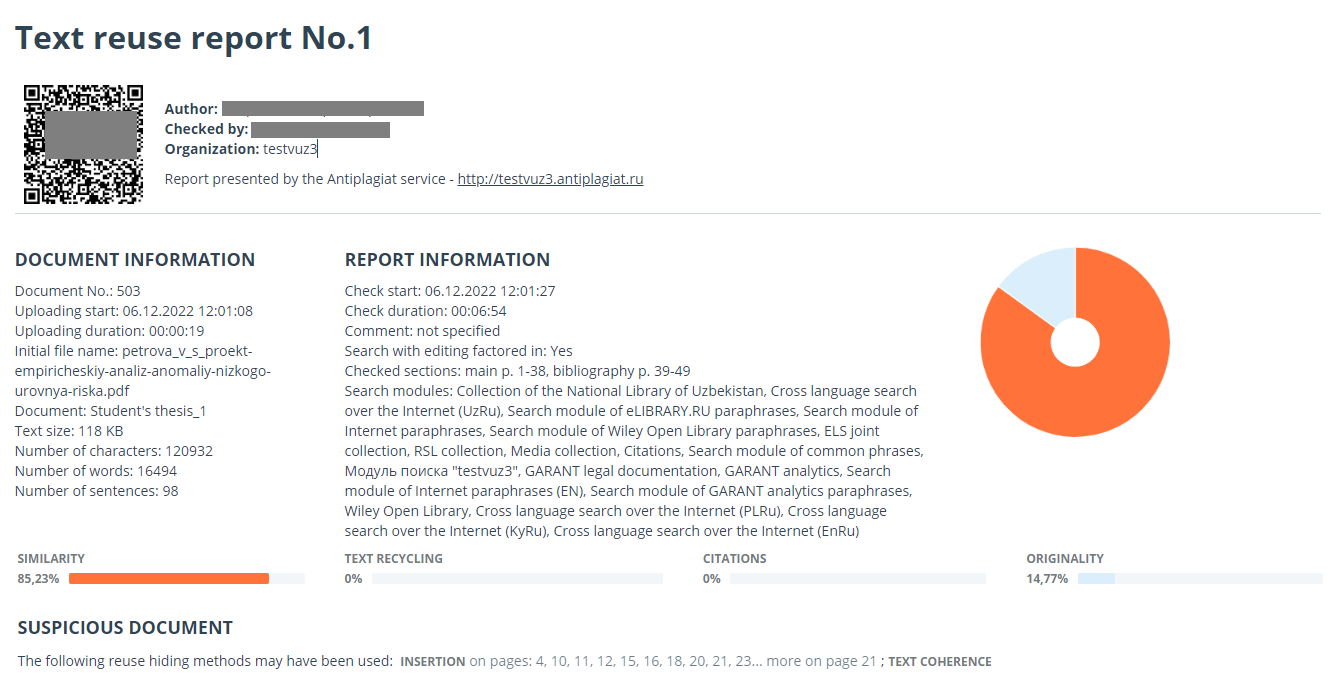
A special block with a suspicious mark is displayed in the full report for a suspicious document. Click on the suspicious sign in the top menu. A window with the words "Suspicious document" and the "Details" button will appear. Click "Details" to go to the "Suspicious document" page and view detailed information about the suspicious text fragments. If the loaded document does not have formatting, instead of transferring to the "Suspicious document" page, the system will display page numbers with potential attempts to cheat the system.

Please note that if the uploaded document has no formatting, then instead of the link to "Suspicious document" there are the page numbers with potential cheating attempts displayed in the full report.
You may also access information about possible cheating on the “See Results” page. To do this, click on the "Details" link in the red suspicious document warning block.

The "Suspicious document" page displays detailed information about the suspicious fragments found in the document. You can read the text of the document in the form in which it was uploaded into the system (keeping the original formatting). If a fragment is found on the document page that may containg cheating attempt, it is marked in red.
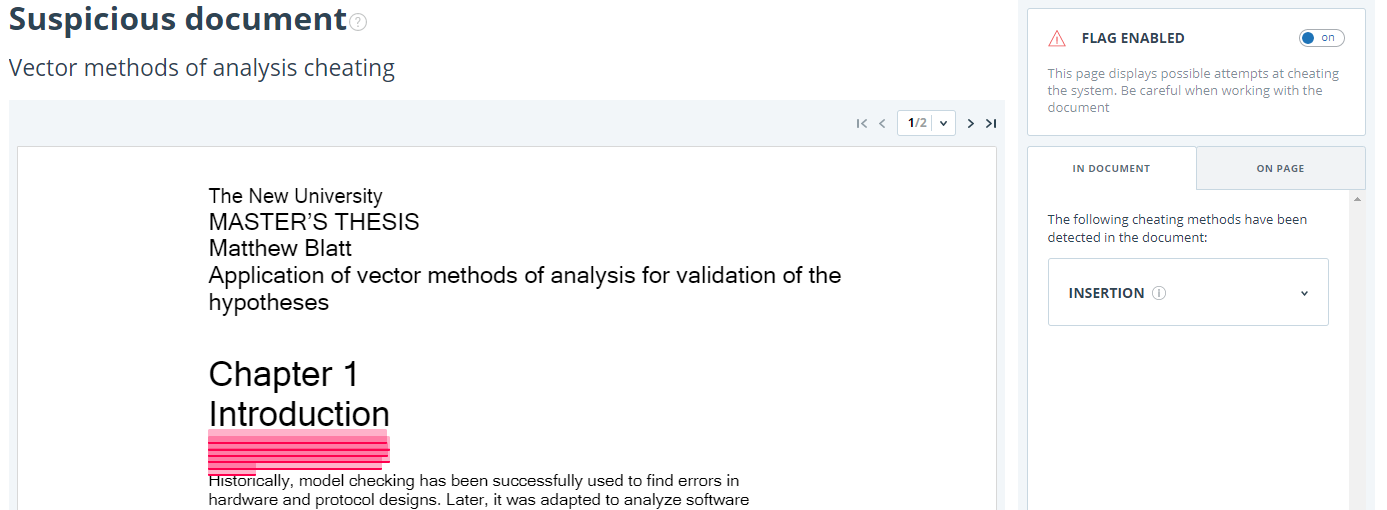
To view information about suspicious fragments for the entire document, click the "In document" tab in the right panel. To view the page numbers, click the name of the cheating method. To go to any of the listed pages, click on the desired number.

The "On page" tab provides information about suspicious fragments on the selected page of the document. To display certain cheating methods, check them and uncheck the others. The selected cheating methods are highlighted in red on the page, the removed cheating methods are underlined with a red line. To select all suspicious fragments on the document page at once, click on "Display all". In order to remove the selection from all the suspicious fragments, click on "Hide all".
It is also possible to review the text of the cheating, if it was extracted during the document processing.

If the document does not contain cheating, you can disable the "Suspicious document" flag. To disable the flag, use the enable/disable button in the upper right corner of the "Suspicious document" page. You can leave a comment explaining why you disabled the "Suspicious document" flag. If you view the "Suspicious document" page through a direct link, you will not be able to disable the "Suspicious document" flag.

If you disable the "Suspicious document" flag:
- the respective icon will not be displayed in the Workspace;
- the brief report will not display information about the cheating;
- in the downloaded forms of reports and in a printable versions the information will appear in the "Suspicious document" section that the flag was disabled, and comments will be displayed;
- in the full report, you will see that the "Suspicious document" flag has been removed – the corresponding icon will become gray;
- you still have access to the "Suspicious document" page.

Potential cheating attempts view is different for documents that have been uploaded prior the availability of cheating detection function. For a brief report, the printable version and downloaded reports the text will be placed in "Suspicious document" blocks with a warning of the presence of suspicious fragments. For a full report, you will see the same text when you hover over the "Suspicious document" icon. The "Suspicious document" page is not available in this case.

Downloading the report
Downloading the report will allow you to save the report as a PDF file. To download the report to your computer, click on the "Export" button on the report viewing page.

Page will appear "Export report". To start the report generation, click on the "Export" button. After some time, the button will change to "Download". Click on the "Download" button to download the file. The download will start automatically, or the file download and save dialogue window will open, depending on your browser settings.
In the downloaded report you will see information about the report and the loaded document, a terminological block with the description of the terms "Similarity", "Quotes", "Originality", "Text recycling", a list of sources and text with markup of quotation blocks (if the user unloads the full report).
Direct link to report from "See results" page
A direct link to the report allows you to give access to the report to any user, including users unauthorized in the system. This link allows you to view the report, however you cannot make changes to the report.
To get a direct link to a report, select the document in the workspace and click the “See results” button. After this click on "Create link" button and select "To full report" or "To brief report" in the drop-down list. A link to the selected type of report will be copied in the clipboard.

Also you may get a direct link to a report from "Full report" or "Brief report" pages. For example, to get a direct link to a full report, open the "Full report" page and click "More" in the top menu, then click the "Direct link to the report" button. A link to the full report will be copied in the clipboard.

The mechanism for obtaining a direct link to a short report is the same as to a full report.
An external user who has followed a direct link will be able to view the report and text metrics (if this function is enabled), print the report to a page, and export the report (if this function is enabled). You cannot edit a report using a direct link.
The user can also share a link to a recheck report or a report with corrections. To do this, in the report history, open the version of the report or adjustment you are interested in. After that, perform the steps described above.
Certificate
Verification certificate is the filled form with the results of the check.
Please note that the functionality allows you to download only a filled form, which is not a legally significant document. You can certify it in your organization. Only your organization can give the legal effect to it.
To download certificate select the document in the workspace and click the “See results” button. After this click on "Download" button and select "Certificate" in the drop-down list.

Also you may download certificate from "Full report" or "Brief report" pages. To do this, open the page with the report and click on the "Certificate" button in the top menu.

Window of downloading of certificate's form will open. Fill in the required field "Author full name". After filling of the fields, click on "Generate certificate" – this will start the loading of the form.
The user with the "Student" role also may download a certificate from the student's workspace. To do this, tick the selected paper and click on the "Certificate" button in the top panel. After that the dowloading of the certificate's form will start.

The created form displays information about the author and the paper, the percent of similarity, quotes, text recycling and originality, the date of evaluation, the list of search modules (for which the evaluation was made), the user, who evaluated the paper. The "Signature date" and "Signature of reviewer" fields are left empty to be filled in by hand.
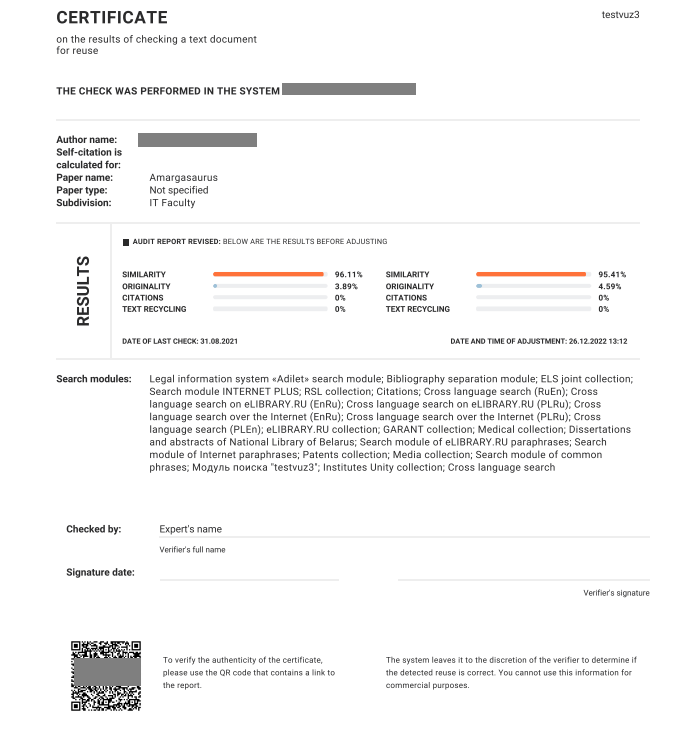
Contact information
For technical support, please contact: support@antiplagiat.ru
If you have questions about purchasing the service for organizations, please contact our Sales department: sales@antiplagiat.ru
If you have questions about the methodology of the system implementation or user training, please contact: metodolog@antiplagiat.ru
